
The Project Gutenberg EBook of Baltimore Hats, by William T. Brigham
This eBook is for the use of anyone anywhere at no cost and with
almost no restrictions whatsoever. You may copy it, give it away or
re-use it under the terms of the Project Gutenberg License included
with this eBook or online at www.gutenberg.org
Title: Baltimore Hats
Past and Present
Author: William T. Brigham
Release Date: May 23, 2012 [EBook #39780]
Language: English
Character set encoding: ISO-8859-1
*** START OF THIS PROJECT GUTENBERG EBOOK BALTIMORE HATS ***
Produced by Bethanne M. Simms, Matthew Wheaton and the
Online Distributed Proofreading Team at http://www.pgdp.net

BALTIMORE HATS
PAST AND PRESENT.
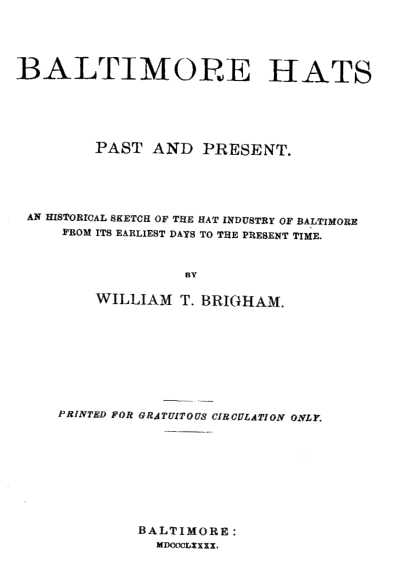
AN HISTORICAL SKETCH OF THE HAT INDUSTRY OF BALTIMORE
FROM ITS EARLIEST DAYS TO THE PRESENT TIME.
BY
WILLIAM T. BRIGHAM.
PRINTED FOR GRATUITOUS CIRCULATION ONLY.
BALTIMORE:
MDCCCLXXXX.
Copyrighted, 1890, by Wm. T. Brigham.
Press and Bindery of Isaac Friedenwald, Baltimore, Md.
 IT is not impossible that some useful information may be conveyed by
this book. Should these pages prove of such service, their cost in
labor is most cheerfully donated.
IT is not impossible that some useful information may be conveyed by
this book. Should these pages prove of such service, their cost in
labor is most cheerfully donated.
This volume is composed of a series of articles which appeared in a Trade Journal, covering a period of two years from 1887 to 1889. It must be accepted as but a brief history of an industry long identified with Baltimore.
Thanks are due the Librarian of the Maryland Historical Society and Mr. B. R. Sheriff for favors in lending rare and valuable old City directories; also to the many citizens who kindly aided and assisted in the search for needed information.
Baltimore, 1890.
| PAGE | ||
| 1. | INTRODUCTORY. | 1 |
| 2. | EARLY DAYS. | 7 |
| 3. | PERIOD OF THE REVOLUTION. | 15 |
| 4. | AFTER THE REVOLUTION. | 23 |
| 5. | EARLY IN THE NINETEENTH CENTURY. | 31 |
| 6. | SOME OLD FIRMS. | 38 |
| 7. | PATRIARCHS OF THE TRADE. | 46 |
| 8. | JACOB ROGERS. | 54 |
| 9. | OLD METHODS. | 62 |
| 10. | JOHN PETTICORD. | 75 |
| 11. | MIDDLE OF THE CENTURY. | 80 |
| 12. | FASHIONS. | 87 |
| 13. | NEW DEVELOPMENTS. | 94 |
| 14. | GROWTH OF BUSINESS. | 102 |
| 15. | HISTORY OF THE MACKINAW HAT. | 106 |
| 16. | MODERN IMPROVEMENTS. | 114 |
| 17. | A MODEL ESTABLISHMENT. | 121 |
| 18. | WAYS AND MEANS OF THE PRESENT TIME. | 129 |
Baltimore Hats—Past and Present.
No. 1.
PAST AND PRESENT have each their independent significance. The past gives freely to us the experiences of others, the present a suitable opportunity to improve upon what has already occurred. With our observation and acceptance of these privileges so easily obtained, we reap the benefit of their advantages and unconsciously find ourselves the gainers both in capacity and intelligence. A history of the past, giving the record of events and circumstances existing before our own day, bringing to our knowledge the accomplishments, business enterprises and undertakings of our predecessors, is a profitable study,2 and the reader gratifies his curiosity in observing how differently things were conducted and managed a century ago as compared with the processes of the present day, exciting a sense of wonder at the rapid progress that has been made in a comparatively short period of time. Think of it! quite within the lifetime of many of us have been the most wonderful of inventions—the steam engine, steam vessels, the telegraph and other wonders3 and triumphs of electricity. The wildest fancy may not be styled visionary in anticipating the appearance of things still more surprising.
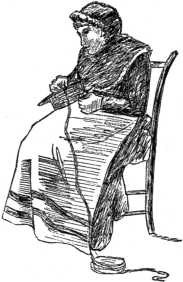
THEN.
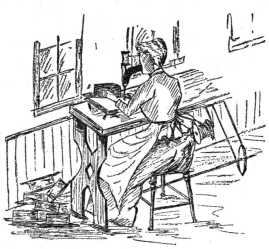
NOW.
Continued familiarity with the present system of making hats has the tendency in a great degree to prevent a recognition, until brought to our notice by comparison of the wide difference existing between the old and new methods, and this common every-day experience assists in making us unappreciative of the remarkable improvements that have been made in this branch of business.
Only a half a century ago the time required to make a single fur hat from the prepared material was fully a week,4 and the average production was two hats per day per man. With the bowing of the fur, the forming and shrinking of the bodies, and the handwork of finishing and trimming, all of which by the aid of modern science and invention is to-day done by machinery more perfectly and completely at the rate in production of twenty times that of fifty years ago, while the sewing of a straw hat, which could hardly be done in an hour by the plodding work of the hand, stitch by stitch, is, by the rapid sewing-machine, made in a minute. When we think of the largest number of stitches our mothers and sisters could take in their needlework by hand and contrast it with the result of the sewing-machine that spins its twenty-two hundred stitches a minute, we are able to gain some adequate idea of the saving of labor, and while we complacently accept these marvellous accomplishments, the question whether it be to the poor and needy a loss or gain is still an undecided problem. With all the advantages now at our command, it appears to us a matter of surprise how our forefathers, with their apparently indifferent methods, could profitably succeed in their labors. With steam engines, sewing-machines and electricity, the quick accomplishments of the present compared with the slow movements of the past tend to make one think we are living in an age of wonders amounting almost to miracles.
What would be the exclamation of the ghosts of our great-grandfathers who, with the rapid trot of an ox-team, drove to church miles away through the storms of winter to exemplify their devotion to the truth of their faith, if suddenly they could rise and observe the luxury of the present modes of transportation in convenient palace cars and palatial steamships, our comfortable and gaudy churches, and our easy ways of communicating instantly with those thousands of miles away from us? Aladdin's wonderful experiences, or the magical change by Cinderella's fairy god-mother, would appear tame to their intense surprise.
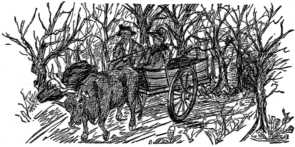
RAPID TRANSIT IN OLDEN TIMES.
In a series of articles it is proposed to give an account of the growth of the hat manufacturing business, one of the most interesting of Baltimore's industries; how at an6 early period it was raised into conspicuous prominence in common with other enterprises undertaken in the active spirit which has always characterized Baltimore merchants as among the foremost of their time. They will also treat of its gradual growth and development, followed by a temporary decline of progress caused by the Civil War and its consequences, and finally of its triumphant stride to place itself again in line with other leading industries of this enterprising metropolis, for without doubt it holds to-day an enviable position among the different trades, a position acquired by the thoroughness, determination and perseverance of those engaged in its development.
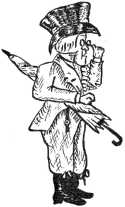
AN OLD TIMER.
No. 2.
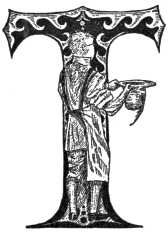 THE spirit of ambition and independence constituting the fundamental
principles of manhood, and inspiring a nobleness of character which in
time of the country's struggle for liberty helped to give her the
benefits of wise counsel, noble patriotism and manly service, was
early manifested by the neighboring colony of Virginia, as in the year
1662 she ventured upon a practical plan to encourage the manufacture
of hats by offering a premium of ten pounds of tobacco for every
domestic hat made of fur or wool. What resulted from this generous act
we are not informed, but there is no evidence that it in any degree
stimulated the production of hats in that colony, and it is a noted
fact that hat-making to any extent has never flourished south of
Baltimore. This8 city seems to have been the southern boundary
line—the geographical limit in that direction—of hat-manufacturing.
As an offset to this enterprising manifesto of Virginia is a petition
in the year 1731 of the hat-makers of London to the "Lords of Trade,"
to enact a law forbidding the American colonists to wear hats not made
in Great Britain. This law was passed, attaching a penalty of five
hundred pounds sterling (twenty-five hundred dollars) for its
violation.
THE spirit of ambition and independence constituting the fundamental
principles of manhood, and inspiring a nobleness of character which in
time of the country's struggle for liberty helped to give her the
benefits of wise counsel, noble patriotism and manly service, was
early manifested by the neighboring colony of Virginia, as in the year
1662 she ventured upon a practical plan to encourage the manufacture
of hats by offering a premium of ten pounds of tobacco for every
domestic hat made of fur or wool. What resulted from this generous act
we are not informed, but there is no evidence that it in any degree
stimulated the production of hats in that colony, and it is a noted
fact that hat-making to any extent has never flourished south of
Baltimore. This8 city seems to have been the southern boundary
line—the geographical limit in that direction—of hat-manufacturing.
As an offset to this enterprising manifesto of Virginia is a petition
in the year 1731 of the hat-makers of London to the "Lords of Trade,"
to enact a law forbidding the American colonists to wear hats not made
in Great Britain. This law was passed, attaching a penalty of five
hundred pounds sterling (twenty-five hundred dollars) for its
violation.
The archives of the New Jersey Historical Society for the year 1731 show that there was one hatter in that colony, and from a history of Boston we learn that sixteen hat-makers of that town were affected by the edict of these despotic English law-makers.
In this manner were the enterprises of the new continent checked and the attempt made to crush out that spirit of progress so manifest in the brightest of the English colonies. It was the continuation of such injustice and oppression that eventually inspired a rebellious spirit to take the place of patience and submission, ending in a revolt, the termination of which secured us liberty and justice and the announcement of our complete independence on the 4th of July, 1776.
The style of hat of this period (1731) had the sides of the brim turned up, with a front of an easy curl, which,9 nearly resembling a cap-visor, made it in shape somewhat between a hat and cap; this seems to have been the first approach toward the "cocked" or three-cornered hat afterwards so extensively used, and to Americans the most familiar of past styles, from its being a fashion of the period of the Revolution, by which it became the prominent part of an historical costume. The arbitrary law before alluded to was afterwards modified, but an uncomfortable restriction continued to be enforced upon all manufactures, for in the year 1750 the English Parliament, among other unjust acts, enacted a law forbidding exportation of hats from one colony to another and allowing no hatter to have more than two apprentices at one time, "because the colonists, if let alone, would soon supply the whole world with hats."
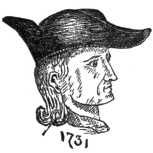
The French fashion of this time had the brazen characteristic of its brim rising erect from the forehead, a style seemingly in keeping with the then irritable condition and reckless agitation of the French people.
Planché, in his "Cyclopædia of Costumes" (vol. 1, page 261), quotes a humorous description, evidently referring to this particular style, as follows: "Some wear10 their hats with the corners that should cover the forehead high in the air, these are called Gawkies; others do not half cover their heads, which, indeed, is owing to the shallowness of their crowns, but between beaver and eyebrows exposes a blank forehead, which looks like a sandy road in a surveyor's plan."
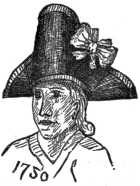
From the year 1750 until after the Revolution there was but little change in the general character of style in men's hats: the custom of erecting the brims by tying or looping them up prevailed. Soon the elevation of the brim of 1750 was abandoned and a change made by looping it at the points of a triangle, producing the three-cornered or "cocked" hat. This was a becoming style we must admit, and one seemingly well suited to the independent, fearless and patriotic characteristics of our forefathers' traits, the possession of which at that time gave us all the comforts that are ours now. The "cocked" hat enjoyed a long popularity, continuing in fashion until near the close of the century, when the "steeple top" and "chimney pot" styles—slang terms for the high beavers—came into vogue, a style which Ashton, an English writer, designates as "the11 hideous head-covering that has martyrized at least three generations."

Departure from settled and accustomed styles created the same furore and astonishment, and subjected the venturesome individual whose inclinations led an advance in fashion to the same exposure to ridicule as affects the "swell" of the present day, and the reporters of "society doings" then were as close observers, as keen in wit, and as unmerciful in criticism as any of their kin to-day. Planché, quoting from the London Chronicle for 1762, refers to fashion of hats at that time as follows: "Hats," says the writer, "are now worn on the average six and three-fifths inches broad in the brim and cocked. Some have their hats open like a church spout or like the scales they weigh their coffee in; some wear them rather sharp like the nose of the greyhound, and we can designate by the taste of the hat the mood of the wearer's mind. There is a military cock and a mercantile cock, and while the beaux of St. James wear their hats under their arms, the beaux of Moorfields-Mall wear theirs diagonally over the left or right eye; sailors wear their hats uniformly tucked down to the crown, and look as if they carried a triangular apple pasty upon their heads."
That "there is nothing new under the sun" is a maxim the truth of which is often verified within the limits of fashionable manners; thus the counterpart of the present captivating custom of carrying in the public ball-room or at the private party the collapsed "opera" hat under the arm is seen in the fashion of 1762, the only difference being, not as now, to doff the hat in the house, but when promenading the street the beau was to be seen with

The folded hat of 1762 differed from the opera hat of the present day also in the softness of the crown, permitting its being flattened, and the brim, as if hinged front and rear, folded at the sides like the corners of a book, while the present opera hat, constructed with jointed springs, allows its cylindrical crown to be flattened down to a level with the brim, which keeps its fixed shape.
Scharf's "Chronicles of Baltimore" give the copy of an13 inventory made in the year 1779 of the personal effects of one Thos. Edgerton, a citizen of the Province of Maryland, and among them is his hat, described as having a gold band and feathers. This hat evidently was the celebrated cavalier style that appears in many of the portraits of Rubens, Vandycke and Rembrandt, of all styles the prettiest and most picturesque ever introduced.
The wide brim of the cavalier hat was arranged as suited the fancy of the wearer, some of whom allowed it to take its natural shape, some would wear it looped up on the side, and by others it was caught up and attached to the crown at different angles; in fact, it was modeled very much as the ladies now-a-days do the "Gainsborough," exercising their own individual fancy as to the treatment of the brim.
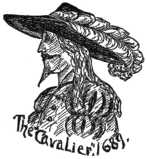
Identical with the interests of Baltimore were the industries of other towns of the colony of Maryland, and among the earliest records referring to the hat business are several advertisements found in the Maryland Gazette, published at Annapolis. In February, 1760, Chas. Diggs advertises "men's and boys' castor and felt hats." In 1761 Barnet West advertises14 "gold and silver band hats, just imported from London," and in April, 1761, appears the advertisement of Nathaniel Waters, of Annapolis, who announces that he has for sale "silver and gold buttons and loops for hats, and that he carries on the hat-making as usual."
About this time Annapolis, being in her palmy days, was the center of gentility and fashionable life; here was congregated the blue blood of English aristocracy, who strove to foster and cultivate the same courtly splendor and etiquette existing in old England, which brought to the venerable place the enviable fame of being considered the most fashionable of our colonial towns.
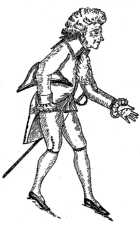
THE BEAU OF 1762.
No. 3.
AN indulgence of those inborn habits of luxury and fondness for rich and expensive dress by the wealthy land owners, comprising the large majority of the population of the Southern colonies, encouraged a demand for articles more elaborate and costly than those produced within the colonial territory; hence imported fabrics were by them largely preferred to those of domestic make. The gay and festive social life, and the means easily acquired from their profitable crops of cotton and tobacco, permitted indulgence in lavish expenditures for articles of fashionable attire and household elegance.
The general customs of the people of the South had the effect of retarding the progress of ordinary trades by not affording sufficient patronage to encourage their successful undertaking; while, on the contrary, from the greater16 necessity with the Northern people of personal exertion and labor to provide the comforts of home life, sprung that support of manufactures which has so largely increased as to place the power and wealth of the country in their hands.
The event of the American Revolution, however, somewhat changed this aspect of affairs. The genuineness of Maryland's loyalty was certainly in one way nobly demonstrated, and by an act of patriotic self-sacrifice, gave to her an unlooked-for reward in a prosperous future. Her people quickly espousing the cause of liberty, at once rejected articles of foreign make and gave choice to those of home production, thus stimulating industries in their midst which had not before flourished from lack of encouragement and support.
Actuated by a feeling of sympathy for their fellow-citizens of Boston—whom the British Parliament in 1774 attempted to shut out from commercial intercourse with every part of the world—the citizens of Baltimore called a town meeting, unanimously recommending a general congress of delegates, to meet at Annapolis, to take action against this indignity on American liberties.
The congress met June 22, 1774, offering their heartiest support not only in resolution, but in the more substantial way of money and food, as aid to their Boston17 friends in the resistance to British tyranny and oppression, supplementing these patriotic resolutions by one making the importation of English goods an act disloyal to the sentiment of American hearts.
The earliest manufacturing hatter in Baltimore, of whom any definite knowledge can be obtained, was David Shields, who kept store at No. 14 Gay street. As the location was on the east side of Gay and the seventh house from the corner of Baltimore street, it probably was about half-way between Baltimore and Fayette streets. Here he sold to his patrons the products of his "back shop" or factory, which was located on the south side of East, now Fayette street, at a point half-way between Gay and Frederick streets. Mr. Shields' father was from Pennsylvania. David Shields was born in the year 1737, and his descendants of to-day include some of the wealthiest and most refined citizens of Baltimore. In Scharf's "Chronicles of Baltimore" his name is mentioned, in connection with others, in the year 1769 as aiding by a general subscription in procuring an engine for the extinguishment of fires; this engine was for the "Mechanical Fire Company," and was the first machine of its kind in Baltimore, costing the sum of two hundred and sixty-four dollars.
Unfortunately, the information gained of Mr. Shields' business career is so meagre as to leave much to the imagination, but it is natural to suppose that in 1769,18 being thirty-two years of age, he must have been established in business.
That Mr. Shields was a public-spirited citizen is further proven by his connection with the First Baptist Society, being one of a committee constituted for the purpose of purchasing a lot upon which to erect a church; this was in 1773, two years before the Revolution. The church was built on Front street, upon the site now occupied by the Merchants' Shot Tower, and was the first Baptist Church erected in Baltimore.
The Federal Gazette announces the death of Mr. Shields, October 4, 1811, in the seventy-fourth year of his age; his funeral taking place from his residence, which was over his place of business, on Gay street.
What may have been the actual condition of the hat business of Baltimore just before the Revolution has been difficult to ascertain. Mr. Shields must have been in business during this period, and it is more than probable that in a town of the size of Baltimore at that date there must have been others engaged in this branch of business, but how many and who they were cannot be ascertained. It is very likely that the restriction placed by English rule upon most manufacturing industries prior to the Revolution operated detrimentally upon this industry also, and while the ordinary kind of wool felt hats were made by the hatter in his own shop, undoubtedly most of19 the fashionable hats sold and worn at that time were of English or French make. Paris (which then, as well as now, was the axis upon which revolved the world of fashion) possibly supplied the wants of Baltimore's highborn gentry, always famous for exquisite dress and refined taste, with the French chapeau—the ton of those days.
As there are no existing detailed statistics of the business of Baltimore during the Revolutionary War, the record of some business firms has been entirely lost, and although some trades have received slight mention in the published histories of the city, a trace of the existence of but two hatters, who afterwards continued in business, is to be found. Since it is known as a fact that fourteen hatters were engaged in business in Baltimore, not later than ten years after the close of the war, we have a right to suppose that more than two must have been in business during the existence of the war.
Among the proceedings of the "Council of Safety" of Maryland, organized at the outbreak of the war, is found the following order: "March 2, 1776. The Council of Safety authorize Major Gist to contract for fifty camp-kettles and as many hats as may be necessary for the battalion, not to exceed 7 shillings apiece." Again, April 6, 1776, "Commissary of Stores of Baltimore is ordered to send to Annapolis 200 of the hats arrived from Philadelphia." Why Baltimore hatters did not supply the20 needed hats for Maryland militia we cannot say, but probably a sharp competition for so large a contract wrested it from them.
The adoption of the "cocked" hat in its various forms as a portion of the military costume of the Continental Army brought about the necessity of making a distinction between civil and military wear.
After the close of the American Revolution France was in a state of civil insurrection, and the French "chapeau" of that time was constructed upon a plan somewhat similar to that of the "cocked" hat. With the termination of the French Revolution appeared the "steeple-top" hat, having a conical crown with stiff curled brim, drooping front and rear, being trimmed with a very wide band and ornamented in front with a huge metal buckle, a change radical enough from those preceding it, but admitting a question as to its comparative intrinsic beauty or to its being a more becoming part of male attire; the style withal certainly proved acceptable, for with slight modifications it has continued and is now embodied in the fashionable silk hat of the present time.
Thus with the opening of the nineteenth century commenced the era of what may be correctly termed the high hat. Ashton, in "Old Times," says of the style of 1790-95: "The 'cocked' hat had gone out, and the galling21 yoke of the 'chimney pot' was being inaugurated, which was as yet of limp felt."
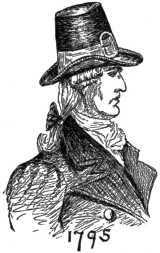
In fashions prevailing at the opening of the new century, particularly those of wearing apparel both for ladies and gentlemen, Paris took the lead, and though with many articles to-day Parisian designs and ideas secure the largest share of popularity, yet in regard to hats for gentlemen it can proudly be said that American-made hats are ahead in point of style and quality, and are no longer dependent upon foreign ingenuity for assistance in securing for them a ready sale; in fact, no American industry to-day stands in a more enviable position relatively to foreign manufactures than does that of hat-making.
The fancy for sentimental hits and political phrases indulged in by modern hatters seems to have been the rage at an earlier period, as is evident from the following, published in the London Times of December 4, 1795: "If the young men of the present day have not much wit in their heads they have it at least in their hats." Among22 the pleasantries we have seen in this way are the following: "Not yours," "Hands off," "No vermin," and "Rip this as you would a hot potato," and other charming sallies of refined and elegant vivacity.
But the wittiest linings are the political ones. The other day we observed one perfectly clean and tidy in which was written: "Avaunt! Guinea Pig," and on the lining of a very powdery hat that lay in the window of the same room were inscribed the two monosyllables "Off-crop." "Guinea pig" and "Off-crop" were probably local political distinctions of the day.
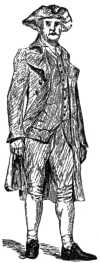
A CITIZEN OF '76.
No. 4.
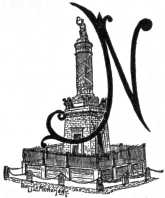 NOT until after the Revolution is it apparent that any attempt was
made in Baltimore to concentrate the hatting industry into a
legitimate business upon any extensive scale, or to separate the
manufacturing from the retail branch of business; in fact, far into
the new century was it the practice of those who manufactured
extensively for the trade, to continue to keep in operation also a
retail establishment.
NOT until after the Revolution is it apparent that any attempt was
made in Baltimore to concentrate the hatting industry into a
legitimate business upon any extensive scale, or to separate the
manufacturing from the retail branch of business; in fact, far into
the new century was it the practice of those who manufactured
extensively for the trade, to continue to keep in operation also a
retail establishment.
The general system of conducting the hat business at the time of which we are now writing was for the hatter to have his "back shop" in the rear and accessible to the "front shop," where the proprietor and his "prentice hand" made the needed supply for the existing or future small demand likely to come; for hats in those days were "built" for service, not for show, and in a manner quite different from those suited to the modern requirement of24 almost a monthly change in style. Then the principle demand came from maturing youth, desiring to assume suitable dignity for entrance into manhood, by procuring a "beaver" which, unless he lived to a patriarchal age, might serve him during his natural life, and that, too, without fear of banishment from society for being out of the fashion.
In the first "Baltimore City Directory," printed in the year 1796, appear the names of nineteen hatters; the business locations of some of the number, it is curious to observe, being at places hardly recognizable by those living at the present day.
Gay street, prior to the year 1808, extended from the water to Griffith's bridge (now called Gay-street bridge), beyond which it was called Bridge street; German lane is now German street; East street is Fayette street, and the euphonious name of Cowpen alley is now dignified by that of Garrett street. Baltimore street was then called Market street, and for a long time after was often designated by either name.
The following names and localities of hatters are found in the Baltimore City Directory published in 1796:
Richard Averson, German lane, between Howard and Liberty
streets.
Joseph Burnet, Welcome alley, Federal Hill.
25
Peter Bond, 13 Bridge street, Old Town.
William Branson, 131 Market street.
Peter Beze, 31 Charles street.
Frederick Deems, Cowpen alley.
Joseph Burneston, 17 George street, Fell's Point.
" Shop, 19 George street, Fell's Point.
George Littig, 141 Market street, Shop on "The
Causeway."
Arnold Livers, Shop, 24 South Calvert street.
Aaron Mattison, Shop, East street, between Calvert
and Gay.
William Mockbee, East street, between St. Paul's lane
and Charles street.
Gasper Morelli, 36 Charles street.
John Parks, Shop, 14 Light street.
Jacob Rogers, 29 South street.
George Smith, 101 Bond street.
David Shields, 14 North Gay street.
John Steiger, 250 Market street.
John Underwood, Alley between St. Paul's lane and
Calvert street.
Daniel Weaver, 19 Front street.
Judging from localities here given, ten of this number were engaged in business as principals, the others were probably journeymen, working at their trade in the various shops in the town.
John Parks, who did business at 14 Light street, had his residence at 137 Market street, about the location now occupied by Clogg & Son as a Shoe store. In the year 1802, No. 137 Market street was occupied by John Walraven, Hardware and Silversmith, and John and Andrew Parks are in the Dry-goods business, at No. 2 Market space.
William Branson, at 131 Market street, appears to have continued business in the same place up to the year 1810. During the years 1800-2 the firm was Branson & Son; their store was the second house west of Grant street, then called Public alley; the place is now occupied by Geo. Steinbach & Son as a Toy establishment.
Aaron Mattison, whose shop, in 1796, was on East street, in 1799 associated his son with himself in business, locating at 16 North Gay street, next door to David Shields. In 1802 Wm. Mattison, probably the son, opened a store at 180 Market street; the firm continuing at 16 N. Gay street as Aaron Mattison & Son. The next year W. Mattison appears at 72 Market street, following which no further record is found of this firm.
No. 180 Market street was two doors east of Charles, on the north side, now occupied by Towner & Landstreet's Rubber store. No. 72 Market street was also on the north side, second house east from Lemon, now Holliday street.
Peter Bond, whose location was No. 13 Bridge street, continued as a hatter in the same place until the year 1806; afterwards he appears to have changed the character of his business, for in 1807 he is found to be a "storekeeper" at No. 9 Bridge street. No. 13 was on the north side of what is now Gay street, the seventh or eighth house beyond the bridge over the Falls. Peter Bond was a member of the committee of "Vigilance and Safety" organized by the citizens of Baltimore in the dark days of anxiety and trouble preceding the invasion of the city by the British in September, 1814.
Richard Averson had his residence on German lane, between Howard and Eutaw streets. At that time there was but one dwelling-house on German lane between Hanover and Liberty streets. German lane, now German street, then extended only from Charles to Greene street. Mr. Averson kept his hat store at No. 4 County wharf, which was the lower terminus of South Calvert street; he had for his neighbors Gerard T. Hopkins, Peter Cox and George Mason, Grocers.
David Shields continued in business at his old locality, 14 North Gay street, certainly until the year 1808, and probably up to the time of his death in 1811. In 1819 his place is found to be occupied by Francis Foster as a hat store.
Arnold Livers would seem to have been the most peripatetic of hatters, and must have caused no little stir and comment among his fellow-tradesmen. Until 1801 he appears as solitary Arnold Livers, carrying on the hat business at 24 South Calvert street, where probably he had a retail "shop." In 1802 the Directory records: "Arnold Livers, 24 South Calvert street," and on Fayette street (probably his residence), also 70 Cumberland Row; Livers & Atkinson, 35 Fell street, and Livers & Atkinson, 10 George street, Fell's Point. In 1804 Arnold Livers is still at 24 South Calvert street, also at 70 Market space, and George Atkinson has succeeded to the firm of Livers & Atkinson. In 1810 it is Livers & Grover, 39 South, corner of Water street. From this time Mr. Livers disappears entirely; one may imagine what a commotion this evidently unsettled man of business must have raised during ten years of these varied and numerous changes, and possibly others of which the Directories give no account.
So rapidly and effectively does time erase the evidence of former labors, and so quickly is the past forgotten, that one is surprised and disappointed at not finding more proof on record of what these worthy apostles of work may have done.
Of the nineteen whose names are in the Directory of 1796, traces of the personal history of but two of the29 number can be found: these are David Shields, before alluded to, and John Parks. In Griffith's "Annals of Baltimore," John Parks is mentioned in the year 1784 as subscribing ten pounds to the funds raised by citizens for the purpose of elevating the courthouse to admit the extension of Calvert street. Then the courthouse stood in the bed of Calvert street, which it spanned, where since has been erected and now stands Battle Monument, commemorating the loss of Baltimore's brave citizens, who gave their lives in defence of their homes against British invasion in 1814.
Among the patriots whose names are inscribed upon this monument by a grateful people, desiring in such way to honor and perpetuate the memory of those who sacrificed themselves in the defence of their homes and firesides, appears that of Joseph Burneston, a hatter, who is found in 1796 doing business at 19 George street, Fell's Point. Thus, while little else is known of Mr. Burneston's career, he is immortalized by a noble deed, and his name is handed down to coming generations to show what sacrifices were made in securing to us that freedom and comfort we now possess, sacrifices which should inspire us with the determination that when similar calls come we will be ready to answer as unhesitatingly as did this patriotic hatter.
From the location of Mr. Burneston's place of business30 it may be inferred that he was only a hat-maker, having no "front shop" or retail establishment, but was merely a maker of hat bodies to be sold to retailers, who themselves finished and trimmed them ready for sale.
Of the hatters of 1796 there is but one through whom can be connectedly traced Baltimore's hat industry from before the Revolution down to the present time; that one is Jacob Rogers, whose long-continued business career brings personal knowledge of him down to a time quite within the recollection of some now living. Singularly enough, by this solitary instance are we able to connect hatting in 1769 with that of 1890, for it is known that Mr. Rogers learned his trade with Mr. David Shields, who was in business in 1769, and engaged in their occupation to-day are several who were apprenticed to Mr. Rogers.
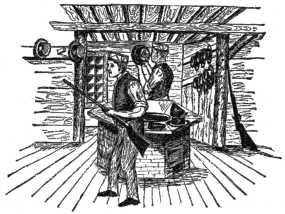
IN READINESS.
No. 5.
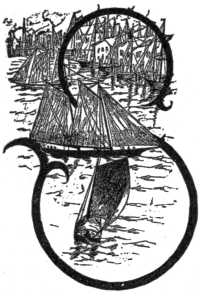 SO wonderful were the recuperative powers of the American people,
after undergoing the trials and sacrifices consequent upon a
protracted struggle for liberty, as to surprise the most sanguine
advocates of self-government.
SO wonderful were the recuperative powers of the American people,
after undergoing the trials and sacrifices consequent upon a
protracted struggle for liberty, as to surprise the most sanguine
advocates of self-government.
Following the train of war came ruin and desolation, but freedom was the birthright of the people, who, though sorely tried by a tremendous outlay in blood and money, were by no means disheartened or discouraged, and without delay they cheerfully took in hand the task of renovation with the same resolute determination that characterized the conflict with their enemies.
The contributions of Maryland to the country's wants during the war were always generous in both men and32 money. Baltimore, after recovering from the exhaustion consequent upon her constant participation in the seven long years' contest for freedom, commenced the foundation of her future commercial greatness, and early in the present century she had attained a commerce greater in extent than that of many older seaport towns. Baltimore "clippers" were celebrated for their marvelous speed, and their white sails were to be seen in the ports of every foreign nation.
Baltimore kept steadily advancing in population and wealth; compared with her rivals, she was precocious. The town was settled in the year 1730, and its increase shows evidence of growth that must have created a surprise in its early days similar to that now experienced by the development in a few weeks of a full-fledged Western city, with its thousands of inhabitants, from its humble foundation of a few straggling hamlets. New York was settled in 1614, Boston in 1630, Philadelphia in 1682, each being well on in existence before Baltimore was born.
At the close of the Revolutionary War the population of Baltimore was 5000; in 1800 it was 26,614. The first United States census, taken in 1810, places the number at 35,580, and in 1820 it had grown to be a prosperous commercial city of 62,738 inhabitants.
The persistent patriotism of Baltimore throughout the Revolutionary War was proverbial; the strong intelligence33 of a majority of its citizens, though of foreign birth, gave them an intuitive knowledge of the distinction between right and wrong, and a fine sense of honor and justice prompted them to act as well as theorize, consequently their personal convictions as to the allegiance they owed their adopted country enabled the city of their choice to assume a strong and patriotic attitude in behalf of America's struggle, and incited them to act with the native element in expelling from their midst all who indulged in hostile acts or expressions. But one sentiment prevailed in Baltimore during the period of the war—that of loyalty to country. The courteous attention and honor paid by citizens to many of those who attained distinction in the war lent great assistance to Baltimore in quickly recovering from the damage she had sustained, and gave to the city a renown for hospitality which has remained by her to the present day.
Washington, Lafayette, Count Rochambeau, and many others united in unrestricted praises of Baltimore's patriotism and liberality, and General Vallette, who commanded a French division of troops, declared: "I will never forget the happy days I have passed among you, citizens of Baltimore, and I beg you will believe that your remembrance will be forever dear to my memory."
The famous General Greene, of Rhode Island, on his way homeward from the war in the South, stopped in34 Baltimore and gave his impression of the city in 1783 as follows:
"Baltimore is a most thriving place. Trade nourishes, and the spirit of building exceeds belief. Not less than three hundred houses are put up in a year. Ground rents are little short of what they are in London. The inhabitants are all men of business."
The period from 1800-30, although interrupted by the war of 1812, when the city was made the immediate battle-ground, was marked by a wonderful growth in both commercial and industrial occupations, and, in common with the general prosperity of the place, hat-making also flourished. In 1810 Maryland is found, from the United States census reports, to have taken the lead in the production of fur hats. Aside from the custom with some retailers of making and finishing the hats they sold, we find in the year 1818 several firms engaged in the manufacture of hats. The products of these factories were distributed throughout the entire South, a section the natural resources of which enabled its people to easily recuperate from the war and quickly become large purchasers and consumers of goods which they did not themselves manufacture. In addition to this desirable field of business was the region of the "Far West," then comprising Ohio, Kentucky and Tennessee, the rapid increase of which in population by35 emigration greatly enlarged the demand for the products of Baltimore's hat industry. This being the most accessible seaport city, regular traffic by wagon trains was established, connecting Baltimore with the West, and giving to the former such superior advantages as to enable its enterprising merchants to secure a large trade, which they long and tenaciously held.
The city directories of that period were not, as now-a-days, issued annually, but at intervals of three or four years, and while furnishing much valuable information, cannot be relied upon for complete correctness, the main object of the compiler being to get the names of house-holders and business men, while many who were temporarily employed, and all who were unmarried though permanently employed, were omitted from registration. Thus the Directory of 1818 does not give a full list of hatters in this city at that time, for while it appears that there were in operation in Baltimore twenty-five hat establishments in the year 1818 (five or six of which were extensive manufactories), the Directory does not show any fair proportion of the number that then must have been engaged in the occupation of hat-making. It may be safely estimated from the extent and the activity of this branch of business at that time, that it gave employment to at least three hundred hands.
Before the year 1810 the "taper crown" or "steeple top" had yielded to the uncompromising demands of fashion, and a style appeared quite different from that which existed at the opening of the century. It had so expanded its crown as to become "bell" in place of "taper," a change so manifestly popular that the "bell crown" since that time, though subject in a greater or less degree to occasional alterations in its proportions, has been for a dress hat the generally accepted style.
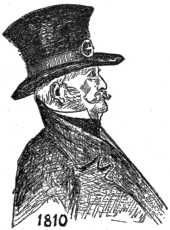
In the style of 1810, Fashion, indulging as she not infrequently does, in a gymnastic summersault from one extreme to another, went in this instance quite as far as prudence would allow: the crown was about seven inches in height and about eight and one-quarter inches across the tip, with a brim about two-and-a-quarter inches wide, the hat being thickly napped with long beaver fur and trimmed with a wide band and buckle. Following the year 1810 there came a reduction in heights of crowns as well as in the proportions of "bell," and a modified style prevailed until the year 1835, when it37 again developed into an extreme "bell" shape with a very narrow brim, a style so utterly extravagant as to bring it into ridicule.
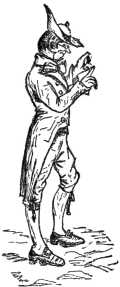
No. 6.
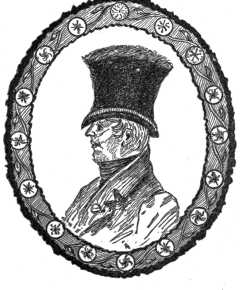 OF the hatters engaged in business in Baltimore during the early part
of this century, many are worthy of more than passing notice as men of
honest character, strict in their dealings and successful in their
business undertakings, gaining the respect of their fellow-townsmen
and becoming honored and trusted citizens of a growing community.
OF the hatters engaged in business in Baltimore during the early part
of this century, many are worthy of more than passing notice as men of
honest character, strict in their dealings and successful in their
business undertakings, gaining the respect of their fellow-townsmen
and becoming honored and trusted citizens of a growing community.
When it is known what were the social surroundings of the "old time" hatter in his youth, it seems a matter of surprise that such good fruit should spring from so unpromising soil.
No one was supposed to be capable of conducting the retail hat business unless he had served his term of apprenticeship to the trade, and apprenticeship in those days was no trivial matter. It meant the surrender at an early age of home, with its parental influences—a most dangerous experience for the untrained youth to encounter—and was entered into by contract for a term of years, binding master and hand to its faithful execution; not merely a verbal agreement between parties themselves, but one solemnly executed by parent and employer, ratified and signed before a magistrate and made binding after all this legal form by the attachment of the portentous seal of the Orphans' Court, before the boy could be considered bounden as "an apprentice to the trade." This was virtually a surrender of all domestic control, giving to one not of "kith or kin" absolute guardianship of the boy. The habits and morals of the "'prentice" were often a secondary consideration, if not wholly neglected.
Thus, as a class, the journeyman hatters often developed into loose, shiftless, migratory characters, spending their liberal wages freely, with no ambition beyond that of daily support; and the surprise is that from such a source came notably honorable men, whose lives seemed to contradict the whole theory of the influence of early training. To these worthy pioneers belongs the credit of laying a secure40 foundation for a trade that from humble beginnings has developed into one of the most prominent industries of the country, requiring extensive capital, liberal business capacity, and one that gives employment to a large, intelligent and skillful class of people.
Among those conducting the hatting business in Baltimore at the opening of the present century, Mr. Jacob Rogers, from his long and successful business career, as well as from being the only one through whom it has been possible to connect this special industry as it existed before the Revolution, with that of the present time, ranks most prominently.
What year Mr. Rogers commenced business cannot be ascertained, but as early as 1796, being nearly 30 years of age, he is found established at the corner of South and Second streets, and in the year 1844 (almost the middle of another century), after the lapse of nearly fifty years, and while actively engaged in business pursuits, his life was suddenly ended; his funeral taking place from his residence, at South and Second streets, his home for more than half a century.
About the year 1805 Mr. Rogers erected a large factory on Second street near Tripolet's alley (now Post-Office avenue). This building was about one hundred and fifty41 feet long, forty wide, and four stories in height. Afterwards a wing extension of considerable proportions was added.

Hat shop of Jacob Rogers, built about 1805.
This establishment was one of the "big" concerns of the day, and Mr. Rogers was credited with conducting, at this time, the most extensive and prosperous hat business in the United States.
To-day not a vestige remains of Mr. Rogers' factory, and upon its site is the extensive structure of the Corn and Flour Exchange. His store, at the corner of South and Second streets, still remains, however, having been42 remodeled from that of Mr. Rogers' time, the ground-floor being now occupied by H.W. Totebush as a cigar store.
In 1819 Mr. Rogers took as partner in business his eldest son, George, the firm becoming Jacob Rogers & Son. In 1823 Mr. Rogers leased from the Carroll family the property No. 129 West Baltimore street, at the corner of Public alley (now Grant street), where a branch establishment was opened, both establishments being continued up to the time of Mr. Rogers' death, in 1844, at which time the firm was "Jacob Rogers & Sons," William, another son, having been admitted about the year 1835.
Upon the occasion of celebrating the laying of the cornerstone of the Baltimore and Ohio Railroad in Baltimore, July 4, 1828 (a great event in the annals of the city), the exhibition of trades was a most prominent feature of the immense procession, and none made a finer display than the hatters. George Rogers commanded that division, a description of which is thus given in the Baltimore Gazette and Daily Advertiser of July 5, 1828: "The hatters' car was drawn by four horses, showing the men at work in the several stages of hat-making. The group attracted much attention; they carried a banner with a white ground, and on the shield was a beaver resting on a scroll bearing the motto: 'With the industry of the beaver we support our rights,' crossed with implements of the trade, the whole supported by the motto: 'We cover all.'"
Bazil Sollers commenced business in 1799 at No. 68 Market street, a location on the north side of the street, four doors east of what is now Holliday street. In 1803 he removed to No. 22 Market street, also on the north side, four doors west of Harrison street; this latter place was previously occupied by Brant & Hobby as a hat store in 1801, and by Stansbury & Hobby in 1802. Mr. Sollers continued in business on Market street until the year 1831, when he removed to North Gay, No. 15, on the northwest corner of Front street. His factory was on East, now Fayette street, three doors east of Lemon street. Mr. Sollers continued in the manufacturing business until about the year 1840.
James Gould & Co. started hat-manufacturing at No. 3 Water street in the year 1802. Water street at that time was numbered from Calvert to South street, subsequently from South to Calvert, and lately renumbered as formerly. No. 3, the second building from Calvert, is now occupied by J.E. Warner & Co., commission merchants. In 1807 Joseph Cox succeeded to the business of James Gould & Co., and kept a retail store on the corner of South and Water streets. Mr. Cox had the reputation of making a superior class of hats, excelled by no manufacturer in the country, selling at both wholesale and retail. Requiring more extensive accommodations, he44 located his factory on the corner of Little Water and Calvert streets, where now stands the large warehouse of Keen & Hagerty, tinware manufacturers. In 1829, disposing of his hat business to Boston & Elder, he associated with himself his son James, the firm becoming "James Cox & Son, dealers in hatters' furs and wools," at No. 1 South Liberty street. In latter years, the members of this firm having acquired a competency, retired from business.
Joseph Pearson was established as a hat manufacturer in 1809, having his shop on Green, now Exeter street, Old Town. He changed his business in the year 1824 to that of dealer in furs, for which Baltimore in early days was a good market, the catch of the trappers of the Alleghanies and of the pioneers of the new West finding their way to Baltimore, and the otter and muskrat of lower Maryland, Virginia and North Carolina also coming in large quantities to this market. The fur business of Baltimore was then of sufficient importance for Jacob Astor to make Mr. Pearson his representative agent. In latter years the firm became Joseph Pearson & Son, dealers in hatters' furs and trimmings, at 260 Baltimore street. All the members of this firm being dead, Edward Connolly, who was in their employ, succeeded to the business, afterwards changing it to a general hat-jobbing business, which is still conducted by Edward Connolly & Son at 207 W. Baltimore street.
John Amos was a well known and respected hatter of Old Town, who commenced business as early as the year 1809 at No. 39 Bridge street, on the north side of the present North Gay street, between High and Exeter. His "back shop," or factory, was on Hillen street. He continued business during the period of thirty years at the same place, and died in 1847 at the age of 67.

No. 7.
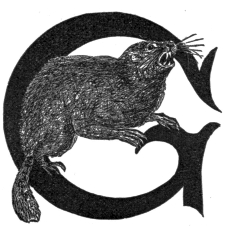
GLEANING more closely in the historic field of the early part of the
century, others are found whose enterprise contributed largely to this
important industry of Baltimore, and whose successful prosecution of
the hat business maintained the credit and position won by their
predecessors.
In the year 1814 Runyon Harris erected a large hat factory on Fish, now Saratoga street. This building was about one hundred and twenty-five feet in length and two and a half stories high.
The business of this establishment was carried on under the style of "The Baltimore Hat Manufacturing Co." While evidence cannot be given, it may be inferred that47 Mr. Harris must, before this date, have been engaged elsewhere in the city in the manufacture of hats, as others entering into business about this time are known to have been apprenticed to Mr. Harris.
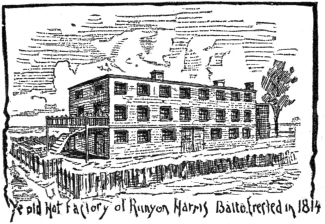
Ye old Hat Factory of Runyon Harris Balto. Erected in 1814
In 1817 Aaron Clap & Co. commenced the retail hat business at 146 Market street, on the north side, five doors east of St. Paul street, and probably identical with the present 104 East Baltimore street, recently occupied by John Murphy & Co., Publishers.
Messrs. Clap & Co. having secured a good location by purchasing the factory of Runyon Harris, engaged extensively in the manufacturing business, which was continued48 by their several successors down to the year 1864, when results of the civil war (so disastrous to Maryland's manufacturing industries) caused its temporary abandonment, but the enterprise established by Messrs. Aaron Clap & Co. has, by an unbroken series of firms, continued to the present time, being now represented by Brigham, Hopkins & Co.
In 1817 Henry Lamson kept a first-class retail hat store at No. 5 South Calvert street, the locality now the southwest corner of Carroll Hall building. In 1822 the firm of Aaron Clap & Co. and Henry Lamson consolidated, making the firm Lamson & Clap, and continuing the retail business at No. 5 South Calvert street, in connection with manufactory. Mr. Lamson in 1827 went to the West Indies in search of health, and died on the island of St. Thomas. He was a gentleman of much social refinement, and was held in high esteem as a citizen.
In the year 1827 the firm of Lamson & Clap was dissolved by the death of Mr. Lamson, and Mr. Wm. P. Cole was admitted, the firm becoming Clap, Cole & Co. After the death of Mr. Clap, which occurred in 1834, his widow's interest was retained and the firm was changed to Cole, Clap & Co.; following this, Mrs. Clap retired and Mr. Hugh J. Morrison became a member of the firm, which was made Cole & Morrison.49 In 1842 Thaddeus and William G. Craft became interested, the firm becoming Cole, Craft & Co., still continuing business at No. 5 South Calvert street (the same place established by Lamson & Clap). About the year 1850 the firm removed to No. 218 West Baltimore street, now 10 East Baltimore street and occupied by Likes, Berwanger & Co., clothiers. In 1853 Mr. Cole associated with him his son, William R., the firm being Wm. P. Cole & Son. In 1857 the firm moved to No. 274 West Baltimore street, present number 46, where they remained until the year 1867, removing then to occupy the building which they had erected at No. 30 Sharp street, now 24 Hopkins Place.
In 1861 Mr. Wm. T. Brigham was admitted to the firm, it then becoming Wm. R. Cole & Co. In 1870 the firm name was again changed to Cole, Brigham & Co., which was dissolved in 1877 by the withdrawal of Mr. Brigham, in which year Mr. Brigham associated with Robert D. Hopkins as the firm of Brigham & Hopkins, locating at No. 128 West Fayette street (present number 211), which firm of Brigham & Hopkins continued until 1887, when it was changed to Brigham, Hopkins & Co. by the admission of Isaac H. Francis.
In 1884 Brigham & Hopkins erected the large and handsome building at the corner of German and Paca50 streets, which the present firm continue to occupy as a factory and salesroom.
In 1810 Andrew Ruff is found at No. 72 Camden street, likely to have been his place of residence. Whether he was then engaged in business is not known, but in 1817 he had a factory on Davis street between Lexington and Saratoga streets, the site now occupied by the stables of the Adams Express Company. About the year 1822 he established a retail store at 158 Baltimore street. In 1842 the firm was Andrew Ruff & Co., at 194 Baltimore street. At one time Mr. Ruff was foreman in the manufacturing establishment of Clap & Cole.
Henry Jenkins, in 1822, was a hat manufacturer at 28 Green street, Old Town, and from 1824 to 1830 Messrs. H. & W. S. Jenkins kept a hat store on the northeast corner of Baltimore and Calvert streets, where afterwards was erected the banking-house of Josiah Lee & Co., now occupied by the Pennsylvania Railroad Company as a ticket office.
Joseph Branson was a hatter in the year 1827 at 182 Market street. He was a son of William Branson, who was engaged in the same business from 1796 to 1817. Joseph Branson ranked as the fashionable hatter of that time. He was a man of considerable military distinction in the State. He raised and commanded the famous51 Marion Rifles, a superb military organization of the city, to which was accorded the honor of receiving General Lafayette upon his visit to Baltimore in 1824.
Mr. Branson is said to have been the first to introduce a thorough system of military tactics in Baltimore. He served several terms in the City Council, and was an active, enterprising citizen. In the year 1831 he went out of business and took the position of inspector in the custom house.
Mr. Charles Grimes was a well-known hatter who commenced business at 42 Baltimore street about 1823. In 1831 he removed to No. 29 North Gay, near High street. He evidently had a love for his first choice, as in 1833 he is found again at 42 Baltimore street. Mr. Grimes retired from business as early as the year 1839. He was extremely fond of the Maryland sport of duck shooting, in which he was associated with many of Baltimore's sporting gentlemen. In 1853 he removed to Philadelphia, enjoying a life of comfort and ease. He was an exemplary man in all the relations of life, and died in the year 1868 at the advanced age of 73.
In 1810 John Petticord was learning his trade with Jacob Rogers, being then fourteen years of age. His honesty and faithfulness were appreciated by his employer, and in 1814 he occupied the position of foreman in Mr.52 Rogers' factory. After continuing in that capacity for some time he commenced the manufacture of hats on his own account, continuing it until the feebleness of age compelled him to abandon it.
Thomas Sappington was a hat manufacturer who, in the year 1831, was located at No. 120 Baltimore street, which at that time was at or near the present number, 116 East Baltimore street. He had his factory on North street near Saratoga. It is known that he was in business for a number of years, but what year he commenced and when he abandoned business cannot be ascertained.
Victor Sarata was a Frenchman who located in Baltimore as early as 1838. He opened a retail store at 259 Baltimore street, and was the first one to introduce the silk hat in this city.
Wm. H. Keevil was a hatter doing a retail business in 1842 at 66-1/2 Baltimore street. He was evidently of the "buncombe" style, and conducted his business in a sensational manner, advertising extensively and brazenly, as will be seen from the following quotation from an advertisement of his printed in 1842:
"Who talks of importing hats from England while Keevil is in the field? Pshaw! 'Tis sheer folly. For while he continues to sell his beautiful hats at his present53 reduced prices, any such speculation as importing hats from Europe will be 'no go' or 'non-effect.' The hatters, therefore, on the other side of the Atlantic had better keep their hats at home, as it would be quite as profitable for them to send 'wooden nutmegs' and 'sawdust hams' to New England, or coals to Newcastle, as hats to Baltimore to compete with the well-known Keevil."
His business existence could not have been of long continuance, as in 1850 his name is not found in the City Directory.
At the close of the first half of this century there were several who afterwards attained prominence both in business and a public capacity, among whom were Joshua Vansant, Samuel Hindes, Charles Towson, George K. Quail, James L. McPhail, P.E. Riley, John Boston, Ephraim Price, Robert Q. Taylor, Lewis Raymo and others, the last two mentioned being the only ones now living.
No. 8.
TO one man more than any other belongs the credit of establishing upon an extensive scale the hat business, which in the early part of the present century was so prominently identified with the growth and prosperity of Baltimore; that person was Jacob Rogers, whose business career in his native city extended over a period of more than fifty years, fortified by a reputation that brought the universal respect of his fellow-citizens, and leaving a worthy example for those succeeding him.
Jacob Rogers was born in the year 1766. As in those days boys were apprenticed at an early age, it may be supposed that when he was fifteen years old he was in the employ of David Shields, with whom it is known he served his term of apprenticeship at hat-making. In 1796 Mr. Rogers is found the proprietor of a retail hat store at the corner of South and Second streets. He was an enterprising man, and succeeded in building up a business of large proportions. He died in 1842, possessed of a fortune amounting to three hundred thousand dollars,55 a large accumulation for those days. In 1805 he built an extensive factory on Second street, near Tripolet's alley—now Post-Office avenue—and adjoining the old Lutheran Church, the spire of which then contained the Town Clock; these old landmarks are now all removed and the location occupied by the stately edifice of the Corn and Flour Exchange. The number of hands employed by Mr. Rogers at his factory and "front shop" was about one hundred, including apprentices. His "plank" shop comprised five batteries, aggregating thirty men; in the finishing shop he employed about twenty-five, and he had usually bound to him as many as fifteen apprentices. This would appear to be a large force for a hat-manufacturing concern of that early period, but it must be remembered that the manual labor bestowed upon one hat then was more than that on some thousands in the present day of labor-saving machinery.
That Mr. Rogers was a strict disciplinarian and an excellent business man is proven by the perfect control he exercised over the large number in his employ, whom he ruled with a firm hand yet with a wise judgment, and while rebuking any disobedience of orders, was feared, respected and loved for his strict sense of honor, justice and propriety.
He boarded under his own roof nearly all his apprentices to the trade; a few were privileged to lodge at home,56 while their board was supplied by their master, as one of the stipulations of their indenture; so Jacob Rogers' immediate family, which was not a small one, was greatly enlarged by the addition of fifteen to twenty wild, untamed "prentice" boys. What would have been the domestic condition of such a family without the ruling influence of a stern master only those can imagine who know the kind of material of which the journeyman hatter of those days was composed. He was a veritable tramp.
As a rule with Mr. Rogers, chastisement immediately followed misconduct; with him the present was the opportune time for punishment, and whether in the home, the shop, or on the street, any of the shop-boys were found doing wrong, correction was given in the then customary way—by flogging.
Mr. Rogers was a conscientious member of the Methodist Church, and maintained a high character for honesty and probity, and recognized as a fair man in all his dealings.
A good story is told to show how, though driving a keen bargain, he was careful not to misrepresent. In his store one day he was divulging to a friend some of the secrets of his business, showing how successfully a prime beaver-napped hat could be made with the slightest sprinkling of the valuable beaver fur, a trick just then57 discovered. Soon after a purchaser appeared inquiring for a beaver-napped hat. Mr. Rogers expatiated upon the marvelous beauty of the "tile," and his customer put the question: "Mr. Rogers, is this a genuine beaver hat?" "My dear sir," said Mr. Rogers, "I pledge my word that the best part of the material in that hat is pure beaver." The hat was bought and paid for and the customer departed, well satisfied with his purchase. At once Mr. Rogers was catechised by his friend, who had earnestly watched the trade, remarking: "Why, Mr. Rogers, did you not tell me that there was but a trifling amount of beaver in that hat you just sold, and you, a church member, so misrepresent to a customer?" "My friend," replied Mr. Rogers, "I made no misrepresentation, I told my customer the honest fact, that the best part of the material of which the hat was made was pure beaver, and so it was."
The journeyman hatter of Mr. Rogers' time was a character, migratory in his ways, his general habit being to work for a short time—a season or less in one place—then, from desire of change or lack of employment, to seek for pastures new. As railroad travel was not then thought of, and stage-coach conveyance a luxury at most times beyond the pecuniary means of the itinerant hatter, the journey was usually made on foot.
Application for work could not be made to the proprietor, but must necessarily go through the medium of58 an employee. Frequently an applicant in straitened circumstances who failed to be "shopped," appealed to his more fortunate fellow-workmen to relieve his destitute condition, who always made a ready and hearty response by providing for his immediate wants and starting him again on his pilgrimage with a light heart and a wish for good luck. This constant wandering habit frequently brought the hatter of those days to a condition of abject dependence, and supplied a large proportion of that vagrant class now denominated "tramps." It was often the boast of these hatter "tramps" that in the period of a59 year or two they would make the tour of the entire country from Portland, Maine, to Baltimore in the South, and Pittsburg, then "far west," "shopping" awhile in some town or village and then marching on in search of another chance.
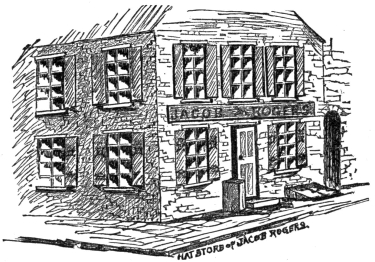
Hat Store of Jacob Rogers.
In the "season" when labor was in demand good workmen did not apply in vain, but most hat factories were subject to dull times between seasons, necessitating a reduction in the number of hands. This general plan was productive of irregularity in the habits of the workman, allowing him to have no settled place of habitation. Baltimore, however, was an exception to the general rule, her factories providing constant employment for her workmen, thus encouraging a deeper interest in their vocation.
It is said that in business Mr. Rogers never knew what dull times were; he kept his hat factory in active operation all the year round. This prosperous condition of things had the tendency to make the Baltimore hatter somewhat of a permanent settler, thereby identifying him more closely with the interests and the growth of his own city, and causing him to become personally concerned in its success and prosperity; an experience quite different from that of his fellow-workmen elsewhere, who were constantly changing their habitation. Thus the Baltimore hatter was reared under conditions favorable to his improvement by serving his apprentice days under60 the influence of a conscientious master. The effect of this early training was manifest in his character as a good citizen ever after, often securing for him in the place of his birth positions of trust, and many of Baltimore's best citizens, and some of her noblest men, received their early training in the model hat-shops of their own city.
With the growing trade of the city, the business of hat-making kept steady pace. The prosperity of the South, and the constant development of the West, provided Baltimore with a wide outlet for her products. Through the business channels of this young and enterprising city flowed a large proportion of the products of the mills and factories of New England, assisting materially the business activity of the place, and it is quite likely that the interests of Baltimore and New England at that time being so connected is an explanation why so many New England people migrated to Baltimore in those days of her prosperity.
With characteristic energy and enterprise, Mr. Rogers extended his business, pushing forward into new fields as the settlement of the country advanced. Besides a large trade with the entire South, the wagon-trains, which were the expresses of those days, distributed his goods throughout the States of Ohio, Indiana, Kentucky and Tennessee, thus securing to him at that time the most extensive business in hat manufacture conducted by any one firm in the United States.
Fortune favored Mr. Rogers, and during his whole business career there was no interruption in the progress of this industry in Baltimore. Not until his death, or after the middle of the century, was there any noticeable decline.
The eventful business career and commendable private life of Mr. Rogers ended on the 10th of April, 1842, he falling suddenly in the old Light-street Methodist Church while attending divine service. The Baltimore Sun of April 11, 1842, mentioned his death as follows:
"The illness of Jacob Rogers, Esq., occurred in Light-street Church; he fell in a faint from which he died an hour after at his residence, No. 9 South street. He was well known and respected as one of the most worthy, industrious, and valuable of our citizens of Baltimore."

WESTERN EXPRESS, 1825.
No. 9.
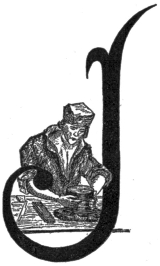
JUST as the first half of the present century was expiring, an
invention was made that at once revolutionized the whole system of
hat-making. A machine was patented in the United States by H. A. Wells,
in the year 1846, which successfully accomplished the work of making
or forming a hat in a very short space of time, which heretofore had
required the slow, tedious and skillful labor of the hands, thus so
equally dividing the century that the first half may be practically
considered as following the old method, and the latter half as using
the new method.
So remarkable was this invention that its introduction quickly produced a change in the character of hats by greatly reducing their cost of manufacture, together with a change in the manner of conducting the hat business.63 To show up the old method of hat-making that existed prior to the use of the Wells machine is the purpose of this chapter, the greater part of the information here given having been gained from an article in "Sears' Guide to Knowledge," published in 1844.
Let us enter a Baltimore hat "shop" of fifty years ago and watch the making of a single hat. Fur and wool constitute the main ingredients of which hats have always been made, because possessing those qualities necessary for the process of "felting," the finer and better class of hats being made of the furs of such animals as the beaver, bear, marten, minx, hare and rabbit. The skins of these animals after being stripped from the body are called "pelts"; when the inner side has undergone a process of tanning the skins obtain the name of "furs" in a restricted sense, and the term is still more restricted when applied to the hairy coating cut from the skin.
The furs to which the old-time hatter gave preference were the beaver, the muskrat, the nutria, the hare and the rabbit, of which the first was by far the most valuable. These animals all have two kinds of hair on their skins, the innermost of which is short and fine as down, the outermost, thick, long and more sparing, the former being of much use, the latter of no value to the hatter. After receiving the "skins" or "pelts," which are greasy and64 dirty, they are first cleaned with soap and water, then carried to the "pulling-room," where women are employed in pulling out the coarse outer hairs from the skins, which is done by means of a knife acting against the thumb, the fingers and thumb being guarded by a short leather shield. The skins are then taken and the fur cut or "cropped" from them, which is done by men dexterously using a sharp knife, formed with a round blade, such as is used now-a-days in the kitchen as a "chopping knife." By keeping this knife constantly moving across the skin the fur is taken off or separated without injury to the skin, which is to be tanned for leather or consigned to the glue factory. The cutting of furs, however, had become before 1844 a business in some measure conducted by itself, and a machine had been invented to separate the fur from the skin, which, though it might be considered now a simple affair, was at that time looked upon as a wonder.

We have said the women in the "pulling-room" cut, tear, or pull out the long, coarse hairs from the pelts, and65 that these hairs are useless to the hatter. But it is impossible completely to separate the coarse from the fine fur by these means, and therefore the fur, when cropped from the pelt, is conveyed to the "blowing-room," finally to effect the separation. The action of the blowing machine is exceedingly beautiful, and may perhaps be understood without a minute detail of its mechanism. A quantity of beaver or any other fur is introduced at one end near a compartment in which a vane or fly is revolving with a velocity of nearly two thousand rotations in a minute. We all know, even from a simple example of a lady's fan, that a body in motion gives rise to a wind or draught, and when the motion is so rapid as is here indicated, the current becomes very powerful. This current of air propels the fur along a hollow trunk to the other end of the machine, and in so doing produces an effect which is as remarkable as valuable. All the coarse and comparatively valueless fur is deposited on a cloth stretched along the trunk, while the more delicate filaments are blown into a receptacle at the other end. Nothing but a very ingenious arrangement of mechanism could produce a separation so complete as is here effected; but the principle of action is not hard to understand. If there were no atmosphere, or if an inclosed place were exhausted of air, a guinea and a feather, however unequal66 in weight, would fall to the ground with equal velocity, but in ordinary circumstances the guinea would obviously fall more quickly than the feather, because the resistance of the air bears a much larger ratio to the weight of the feather than that of the guinea. As the resistance of air to a moving body acts more forcibly on a light than a heavy substance, so likewise does air when in motion and acting as a moving force. When particles of sand or gravel are driven by the wind, the lightest particles go the greatest distance. So it is with the two kinds of fur in the "blowing machine," those fibers which are finest and lightest are driven to the remote end of the machine.
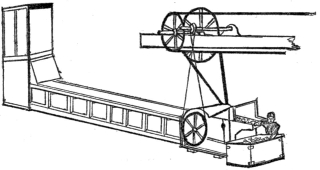
BLOWING ENGINE.
The "body," or "foundation," of a good beaver hat is generally made of eight parts rabbit's fur, three parts67 Saxony wool, and one part of llama, vicunia, or "red" wool. A sufficient quantity of these for one hat (about two and a half ounces) is weighed out and placed in the hands of the "bower." On entering the "bowing-room" a peculiar twanging noise indicates to the visitor that a stretched cord is in rapid vibration, and the management of this cord by the workman is seen to be one of the many operations in hatting wherein success depends exclusively on skillful manipulation. A bench extends along the front of the room beneath a range of windows, and each "bower" has a little compartment appropriated to himself. The bow is an ashen staff from five to seven feet in length, having a strong cord of catgut stretched over bridges at the two ends. The bow is suspended in the middle by a string from the ceiling, whereby it hangs nearly on a level with the work-bench, and the workman thus proceeds: The wool and coarse fur, first separately and afterwards68 together, are laid on the bench, and the bower, grasping the staff of the bow with his left hand and plucking the cord with his right hand by means of a small piece of wood, causes the cord to vibrate rapidly against the fur and wool. By repeating this process for a certain time, all the original clots or assemblages of filaments are perfectly opened and dilated, and the fibers, flying upwards when struck, are, by the dexterity of the workman, made to fall in nearly equal thickness on the bench, presenting a very light and soft layer of material. Simple as this operation appears to a stranger, years of practice are required for the attainment of proficiency in it.
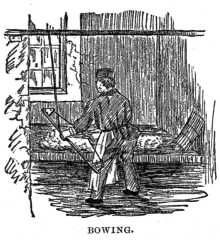
The bowed materials for one hat are divided into two portions, each of which is separately pressed with a light wicker frame; the light mass of fluffy fur, after being pressed with the frame, is covered with a wet cloth, over which is placed a piece of oil-cloth or leather called a "hardening skin," until, by the pressure of the hands backwards and forwards all over the skin, the fibers are brought closer together, the points of contact multiplied, the serrations made to link together, and a slightly coherent fabric formed. These two halves, or "batts," are then formed into a hollow cap by a singular contrivance. One of the "batts," nearly triangular in shape, and measuring about half a yard in each direction, being69 laid flat, a triangular piece of paper, smaller in size than the batt, is laid upon it, and the edges of the batt, being folded over the paper, meet at the upper surface, and thus form a complete envelope to the paper. The two meeting edges are soon made to combine by gentle pressure and friction, and another "batt" is laid on the other in a similar way, but having the meeting edges on the opposite side of the paper. The double layer, with the enclosed paper, are then folded up in a damp cloth and worked by hand; the workman pressing and bending, rolling and unrolling, until the fibers of the inner layer are incorporated with those of the outer. It is evident that were there not a piece of paper interposed, the whole of the fibers would be worked together into a mass by the opposite sides felting together, but the paper maintains a vacancy within, and when withdrawn at the edge which is to form the opening of the cap, it leaves the felted material in such a form as to constitute, when stretched open, a hollow cone.
The "battery" is a large kettle or boiler open at the top, having a fire beneath it, and eight planks ascending obliquely from the margin, so as to form a sort of octagonal work-bench, five or six feet in diameter, at which eight men may work; the planks are made of lead near the kettle, and of mahogany at the outer part, and at each plank a workman operates on a conical70 cap until the process of felting or "planking" is completed. The "battery" contains hot water slightly acidulated with sulphuric acid. The cap is dipped into the hot liquor, laid on one of the planks, and subjected to a long felting process; it is rolled and unrolled, twisted, pressed, and rubbed with a piece of leather or wood tied to the workman's hand, and rolled with a rolling-pin. From time to time the cap is examined, to ascertain whether the thickness is sufficient in every part, and if any defective places appear, they are wet with a brush dipped in the hot liquor, and a few additional fibers are worked in. Considerable skill is required in order to preserve such an additional thickness of material at one part as shall suffice for the brim of the hat. When this felting process has been continued about two hours, it is found that the heat, moisture, pressure and friction have reduced the cap to one-half its former dimensions, the thickness being increased in a proportionate degree, assuming a conical shape.
The "cap" is then taken to the "water-proofing" or "stiffening" room, where the odor of gum, resins and spirits gives some intimation of the materials employed. Gum-lac, gum-sandrach, gum-mastic, resin, frankincense, copal, caoutchouc, spirits of wine and spirits of turpentine, are the ingredients (all of a very inflammable nature) of which the water-proofing is made. This is71 laid on the cap by means of a brush, and the workman exercises his skill in regulating the quantity at different parts, since the strength of the future brim and crown depends much on this process.
After another heating in a hot room, called "stoving," by which the spirit is evaporated, the exterior of the cap is scoured with a weak alkali, to remove a portion of the gummy coating, and thereby enable the beaver fur with which it is to be "napped" or "coated," to adhere.
A layer of beaver fur is spread, and, by means of the "hardening stick," is pressed and worked into a very delicate and light felt, just coherent enough to hold together. This layer, which is called a "ruffing" or "roughing," is a little larger than the cap-body, and to unite the two, another visit to the "battery" is necessary. The cap being softened by immersion in the hot liquor, the "ruffing" is laid on it, and patted down with a wet brush, a narrow strip of beaver being laid round the inside of the cap to form the underside of the future brim. The beavered cap is then wrapped in a woolen cloth, immersed frequently in the hot liquor, and rolled on the plank for the space of two hours. The effect of this rubbing and rolling is very curious, and may be illustrated in a simple manner: if a few fibers of beaver fur be laid on a piece of broadcloth, covered with tissue paper, and rubbed gently with the finger, they will penetrate through72 the cloth and appear on the opposite side. So, likewise, in the process of "ruffing," each fiber is set in motion from root to point, and enters the substance of the felt cap. The hairs proceed in a pretty straight course, and just enter the felt, with the substance of which they form an intimate union. But if the rolling and pressing were continued too long, the hairs would actually pass through the felt, and be seen on the inside instead of the outside of the cap; the workman therefore exercises his judgment in continuing the process only so long as is sufficient to secure the hairs in the felt firm enough to bear the action of the hat-brush in after-days.
At length the cap is to assume somewhat the shape of a hat, before it finally leaves the "battery." The workman first turns up the edge of the cap to the depth of about an inch and a half; and then draws the peak of the cap back through the centre or axis so far as not to take out the first fold, but to produce an inner fold of the same depth. The point being turned back again, produces a third fold, and thus the workman proceeds, till the whole hat has acquired the appearance of a flattish circular piece, consisting of a number of concentric folds or rings, with the peak in the centre. This is laid on the "plank," where the workman, keeping the substance hot and wet, pulls, presses and rubs the centre until he has formed a smooth flat portion equal to the intended crown of the hat. He73 then takes a cylindrical block, on the flat end of which he applies the flattened central portion of the felt, and by holding a string down the curved sides of the block, he causes the surrounding portion of the felt to assume the figure of the block. The part which is to form the brim now appears a puckered appendage round the edge of the hat; but this puckered edge is soon brought to a tolerably flat shape by pulling and pressing.
The workman then raises and opens the nap of the hat by means of a peculiar sort of comb, and then shears the hairs to a regular length. Connoisseurs in these matters are learned as to the respective merits of "short naps" and "long naps," and by the shearer's dexterity these are regulated. The visitor recognizes nothing difficult in this operation, yet years of practice are necessary for the attainment of skill therein, since the workman determines the length of the nap by the peculiar position in which the long, light shears are held. A nap or pile as fine as that of velvet can be produced by this operation.
However carefully the process of "blowing" may be performed in order to separate the coarse fibers of the fur from the more delicate, there are always a few of the former left mingled with the latter, and these are worked up during the subsequent processes. Women are employed, therefore, after the hats have left the "finishers,"74 in picking out with small tweezers such defective fibers as may present themselves on the surface of the hats.
Lastly, the hat is placed in the hands of a workman whose employment requires an accurate eye and a fertile taste in matters of shape and form: this is the "shaper." He has to study the style and fashion of the day, as well as the wishes of individual purchasers, by giving to the brim of the hat such curvatures in various directions as may be needed. Simple as this may appear, the workman who possesses the requisite skill to give the acceptable curl to the brim which is to create the finishing touch for the hat is a desirable hand, and can command a high rate of wages.
Thus, in our imaginary tour through an old-fashioned hat factory, we have seen the many skillful manipulations then required to make a hat, which, when compared with modern processes, awaken in our minds a sense of wonder at the change.

No. 10.
THE subject of this article, who died in Baltimore, October 11th, 1887, in the 92d year of his age, was probably the oldest hatter in the United States. His identity with Baltimore hatting all the days of his life made him prominent in connection with that industry. Born but a few years after the thirteen states had by compact formed a republic, Washington being President of the United States, Mr. Petticord lived to see in office every President down to that of President Cleveland.
When he was a young man of business, savages roamed and tented where beautiful and populous cities with all the advantages of refinement and art now exist.
During his lifetime the population of his own city changed from 25,000 to 400,000, and the United States extended its area of territory from the limits of the thirteen original states, which was 367,000 square miles, to upwards of 3,000,000, increasing its population from 5,000,000 to 60,000,000.
When John Petticord first made hats, the "Cocked" or "Continental" style was in vogue. No more curious museum could be collected than specimens of the various freaks of fashion in hats that appeared during the lifetime of this old hatter.
John Petticord was born in Baltimore in 1796. At an early age he was apprenticed to John Amos to learn the trade of hatting; soon after finishing his service of apprenticeship, he secured work in the establishment of Jacob Rogers. He was faithful to his duties, serving his master with that same conscientiousness that he would have done for himself, soon becoming foreman of Mr. Rogers' extensive factory. After serving with Mr. Rogers for some years, he entered into business as a manufacturer on his own account, and continued until feebleness of age compelled him to abandon it. He was a man of quiet, simple habits, his chief ambition being to lead an upright life, and appear before God and his fellow-creatures an honest man.
John Petticord was exemplary in character and habits, modest and gentle in his disposition, pure in his faith and in his living; he had no enemies, and was always known as a reliable man. During his long career as foreman or master of the shop, he never had a quarrel or a serious difficulty with the many who came under his control. He77 never drank intoxicating beverages, although in his early days that was the general custom, which, with hatters, was unfortunately the universal habit. His manliness and strength of character were also well displayed by his never chewing or smoking tobacco. He was patient and methodical, an indefatigable worker at his trade, believing that undivided attention to his work was a duty he owed to others.
John Petticord was a patriot, being one of that noble band who fearlessly stood and successfully resisted the British attack upon Baltimore in 1814. At that time he was a youth of nineteen working at his trade. At noon-time on the eventful September 12th, 1814, the "tocsin" was sounded to call to arms every able-bodied citizen to defend his home and fireside, and, if possible, prevent the destruction of their beautiful city. At the first sound of the cannon, which was the signal agreed upon, John Petticord left his unfinished noonday meal, seized his musket, and was one of the first to join the ranks of his company. The day was desperately hot, and a forced march of two miles to the battlefield brought them, dusty, tired and thirsty, face to face with the enemy, who was in a fresh condition and eager for fight. Petticord's canteen, as all others, by regulation orders, was filled with whiskey, but he, being a temperance man, would not assuage his78 thirst with grog. Famishing for water, he obtained permission from his superior officer to go a short distance away, where a "squatter" was dispensing cider for the comfort of the soldiers and profit to himself. Petticord, emptying his canteen of whiskey on the ground, had it filled with hard cider, and quenched his thirst with a good round drink. That hard cider, together with heat and exhaustion, came about as near ending the earthly career of John Petticord as did the storm of enemy's bullets which whizzed about his head. On that trying day the bravery of this man was well tested. He stood manfully in position while his comrade on the right fell dead at his feet, and the one on his left was removed wounded from the battlefield, he himself receiving a slight wound on the finger. The riderless white horse of the British General Ross, who had just been killed, pranced by in front of the rank in which Mr. Petticord was stationed, and the hearts of himself and comrades beat lightly with hope of success, as the shouts of the Americans echoed along the line, announced the death of the invaders' great leader, encouraging a grand rally that gave them the victory of the day. Mr. Petticord, though a brave soldier in the time of his country's need, was a man of peace, and, upon the ending of hostilities with Great Britain, resigned his position in the eighth company of the 27th Regiment of Maryland militia.
Baltimore always honors her noble band of brave defenders, and upon each anniversary of the 12th of September a public celebration is given, and the Old Defenders occupy the post of honor. It is but a few years since they marched with lively and steady step to martial music; later on, age required their appearing in carriages in the procession, and each year, at the annual dinner given by the city, their number has grown less and less.
The present year but three were on earth to answer to the "roll call," and but one able to appear at the banquet. Who can realize the sad feelings of the last of such a noble band? Feeble Old Age, with its infirmities, mindful of its duty, sat perhaps for the last time around the banquet board, where, with friends and comrades, he before had enjoyed happy and jovial times, his spirits were cheered and the occasion made as pleasant as possible, by the presence of many of Baltimore's honored citizens; but not to see a single face of the many with whom during the seventy-five long years he had kept up a pleasant association, is an experience others cannot imagine.
With Mr. Petticord's death, but two[1] are left of that noble band who so bravely protected our rights and fought for and firmly secured that liberty and freedom we of the present day are enjoying.
No. 11.

BALTIMORE hat-manufacturing interests at the middle of the century
suffered greatly by comparison with those of an earlier period. That
which had been a prominent industry, engaged in by active,
enterprising men, and extending steadily and widely, keeping pace with
the growth of the country, and giving encouragement to the continued
employment of skilled labor, was at the middle of this century
gradually falling off in volume and importance, and continued to
decline until what was once a thriving and prosperous industry of the
city, became one almost of insignificance.
In the government census of 1810, the statistics regarding hat manufacturing place Maryland as leading in the manufacture of fur hats. While Connecticut, New York,81 New Jersey and Pennsylvania gained rapidly, still this business in Baltimore continued to increase and grow, until during the period from 1825 to 1850 it reached the height of its prosperity.
Before the year 1850 the once prominent concern of James Cox & Sons had retired from the hat-manufacturing business, and the oldest and wealthiest firm was contemplating liquidation, as Messrs. George and William Rogers, of the firm of Jacob Rogers & Sons, had decided to discontinue the business left by their father, choosing to follow other occupations. The retirement of these two firms, so long and closely identified with the mercantile and manufacturing industries of Baltimore, which had successfully contributed by their faithful business labors to its growth and prosperity, was a serious blow to the interests of the city. This change left in the field but one important firm who had been their contemporary—Cole, Craft & Co.—of which the late Wm. P. Cole was the active business partner. This firm followed in succession the business established in 1814 by Runyon Harris, and was the predecessor of the present firm of Brigham, Hopkins & Co.
Much speculation might be indulged in as to the real cause of the decline and loss to Baltimore of so important an industry, but the plain facts force but one conviction;82 namely, the unwillingness of these successful old manufacturers to adopt newer methods of hat making, leading to such reduction in cost, through improvements, as to preclude the chance of their successful competition with those of more progressive ideas.
While Baltimore hat makers clung tenaciously to the old ways, whereby labor and expense were incurred unnecessarily, those at the North were readily adopting the various new methods by which improvements in the art of hat making were constantly being made; thus, with the use of newly invented machinery, the cost of making hats was greatly lessened, and the Northern manufacturer constantly gained in competition with those of Baltimore.
The invention of the Wells Forming Machine added largely to the misfortune of this business. An expensive machine, with a comparatively tremendous production, required a large market as an output; a heavy royalty also was attached to it, and the business of Baltimore at that time appeared not to be in condition to justify its introduction. Though the machine was invented in 1841, it was not until the year 1852 that the venture was made to introduce into Baltimore the Wells Hat-body Forming Machine. With the pecuniary assistance of Wm. P. Cole, Messrs. Bailey & Mead, in 1852, commenced hat forming by machinery, the "mill" being located on Holliday83 street, and afterwards removed to Front street (present number 320).
From failure of support, caused by inability to revive the depressed condition of the hat business, the venture of Messrs. Bailey & Mead was not successful, and Mr. Mead retiring from the firm, the business was continued by Messrs. Bailey, Craft & Co., mainly in the interest of Mr. Cole's factory, until about 1869, when hat forming by machinery in Baltimore was entirely abandoned, followed with the retirement of Mr. Cole from the manufacturing business.
Charles Towson, who established himself in the retail hat business in 1836, on Eutaw street, near Lexington, entered into partnership in 1853 with Mr. Mead, the firm being Towson & Mead; they commenced hat manufacturing at No. 10 Water street, in the factory formerly occupied by Jas. Cox & Sons. The business was carried on for about one year, when it was abandoned and the firm was dissolved. Other parties made fruitless attempts to restore to Baltimore the prestige it once held in this business. To one person, however, is due the credit of maintaining a long, persistent and noble fight against odds and difficulties, and who, after all chances to restore vitality to an apparently pulseless enterprise seemed lost, retired from the contest, unscarred and full of honors,84 after a creditable business career of forty-six years, carried on in the same factory where fifty-two years before he entered service as a boy. This person was Mr. Wm. P. Cole, who engaged in the manufacturing business in 1827, as a member of the firm of Clap, Cole & Co.
At the time of Mr. Cole's retirement from the manufacturing business he was associated with his son, Wm. R. Cole, and his nephew, Wm. T. Brigham, as the firm of Wm. R. Cole & Co., who were then engaged in the jobbing hat business and located at No. 30 Sharp street, now 24 Hopkins Place. In the year 1870 the firm was changed to Cole, Brigham & Co.; Mr. Cole retiring from active business only upon the dissolution of that firm in 1877, having been engaged in business on his own account more than half a century, leaving behind a record bright with faithfulness to duty, unspotted by any unmanly business transaction, brilliant in having met every business obligation; for, during the whole course of a long business life, he so systematically managed his affairs as to allow him to pass safely through the many perilous business periods he encountered.
As a manufacturer, Mr. Cole acquired a wide reputation for the class of goods he produced, and when the demand was most exclusively for soft felt hats, those manufactured by him were considered the best made in85 the United States, and were sought by retailers far and near.
While at the outbreak of the Civil War there may have lingered a vital spark in the hat industry, that event gave it, apparently, a death thrust. The relative position of Baltimore to both sides was disastrous to its business interests; being close upon the dividing line of hostilities, the sympathies of a large part of its citizens were enlisted in the cause of the South, while, singularly enough, the larger proportion of the wealth and business interests of the city was centered in persons allied by family ties to those of the North, who earnestly upheld the cause of the Union. Cut off from all intercourse with the South—its legitimate field for business—the share of Western trade that was enjoyed by Baltimore was lost by the strategy of war, for with the partial destruction of the Baltimore and Ohio Railroad the channel of her Western trade was diverted, and it drifted in other directions. While dissension and strife were being stirred in Baltimore and her industries lying dormant, business at the North was being stimulated by State and Government calls for articles necessary to equip an army for service. Hats were a needful part of an army's equipment, and Northern hat manufacturers were called upon for the supply; their factories soon assumed the life and activity of prosperity, creating86 a demand for additional skilled labor with good pay; this induced the unemployed Baltimore hatter to migrate and seek other places for his support. Thus did Baltimore part with an industry of importance closely identified with its prosperous early days, which, after passing through many vicissitudes, dwindled gradually until it became apparently extinct.

No. 12.
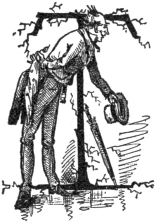
THE high crown hat, vulgarly termed "stove-pipe," may be taken as the
general indicator of fashions existing during the period of the
present century. Following the "cocked" hat (the counterpart of the
French chapeau), which style prevailed at the time of the American
Revolution, was the "steeple top," which had a conical crown. This
shape for a high hat was soon abandoned and the bell crown
substituted, and so acceptable has this particular style proved that,
since the opening of this century, it has held supremacy as the
fashionable head-covering for man, despite frequent attempts to
destroy its popularity by the introduction of other shapes, or the
advocating of a change as practical.
High hats were first napped with beaver fur, which88 material, being expensive, necessarily made costly hats. Otter fur was afterwards used, then muskrat, which greatly lessened their cost.
"Scratch" or "brush" hats (terms used for hats made with a felt body and afterwards combed or scratched until a nap was raised) were manufactured and worn prior to the middle of the century. These were all stiffened high hats, and constituted the dressy article of headwear until the introduction of the silk hat, which for the last fifty years has maintained its ascendency as the leading article of fashion in gentlemen's hats.
About the year 1830 the beaver hat assumed huge proportions of crown, having a very heavy "bell," measuring full seven inches in height and nine inches across the tip; to this crown was added an insignificant brim of only one and a half inches in width. These hats were covered with a beaver nap of such a length that it waved with the wind, and its appearance upon the head of the wearer was as outre and unique as the "shako" on the head of a modern drum-major.
To more forcibly illustrate the proportions of this style of hat, we may say that its actual capacity was nearly a peck.
Besides the high hats of either beaver, brush or silk, caps made of cloth or fur were much used prior to the89 introduction of the soft felt hat, and continued to be so until an incident occurred which created a sudden revolution in the tastes of the American people regarding their head-dress.
The visit of Louis Kossuth, the eminent Hungarian patriot, to this country in the year 1851, had the effect of producing a wonderful change in the fashion of hats. The one worn by Kossuth was a high unstiffened black felt trimmed with a wide band, and was ornamented with an ostrich feather. The immense popularity of this famous foreigner with all Americans brought about the fashion of a similar hat. Never before or since in this country did the introduction of a new fashion in hats spread with such rapidity as did the "Kossuth." All hat factories in the country were taxed to their utmost capacity to supply the demand, until every American citizen, old and young, was to be seen wearing a soft hat ornamented with an ostrich plume. It was the "Kossuth" that marked the era of the introduction of the soft or slouch hat, and stimulated the sale of that undress article of headwear, which continued in vogue throughout the United States for a number of years. The soft hat appeared in many forms and styles, some of which became universally popular. The "wide-awake," brought out during the election campaign of Abraham Lincoln, in the90 year 1860, was a noted and successful style. It was a low crown, white felt, with wide black band and binding.
Robert Bonner's original and successful advertising of his newspaper, the New York Ledger, was a sensation of the day, and the "Ledger" was the name given to a soft hat that commanded a great sale. The peculiarity of the "Ledger" was a narrow leather band and leather binding.
The "resorte" brim was an American invention, introduced about the year 1863; it was simply a wire held to the edge of the brim of a soft hat with a binding, and so extended as to maintain a flatness, and permit its conforming to the head without destroying its outlines. This invention was patented, and its extensive use brought large profits to the owners of the patent.
The event of the Civil War gave an increased stimulus to the use of the soft hat. With the South in a state of excitement, alarmed with portentous fears of a sectional war, such matters as pertained to elegance of dress were banished from the minds of its people, and the North, with a large army recruiting from its citizen class, brought the universal practice of economy among the American people, limiting their indulgence in expenditures for articles of dress considered as luxuries, and the silk hat falling under that ban, dropped almost into absolute disuse. With the return, however, of prosperity, an apparent91 desire for a more dressy article was manifest, and the stiff felt hat generally denominated the Derby was introduced.
The derby was made in various proportions of crown and brim, as the caprice of fashion dictated, and was, as its name might imply, an adopted English style; it gradually grew in favor with Americans, until it became the universal fashion of the day, maintaining that position for several years. From an increased popularity it has been brought into such common use as to again create a growing desire for an article claiming something bearing a more exclusive mark of gentility or dignity, which the silk hat meets, and the silk hat is again so increasing in use as to establish the certainty of its maintaining with the American people its wonted place of priority as the article of genteel head-dress, marking the standard of fashion and style.
Baltimore, always noted for its readiness in accepting foreign fashions, must have been among the first of American cities to adopt the silk hat, which was claimed to be of French invention, but if there be any foundation for the following narrative, the first silk hat was not made in Paris, but in China. It is stated that a French sea-captain, while sailing on the coast of China, desiring to have his shabby napped beaver hat, which had been made in Paris, replaced by a new one, took it ashore, probably to92 Calcutta or Canton, to see if he could procure one like it. As Parisian styles were not in vogue in China, he found nothing of closer resemblance than the lacquered papier-mache or bamboo straw. The keen shrewdness of the Chinaman, however, quickly suggested a near imitation in silk-plush. This is said to have happened in 1830, and the captain returning to Paris, showed the Chinaman's product to his own hatter, who, upon perceiving its beauty, at once attempted its introduction as a fashion, which has long ruled nearly the whole world.
The first silk hat produced in Baltimore is said to have been made by one Victor Sarata in 1838, though some contend that Jacob Rogers was the first to make such goods; but as the silk hat was looked upon as an innovation, and its introduction opposed by hat makers of that time, as being detrimental to their interests, it is more than probable that Mr. Rogers did not give encouragement to the manufacture of an article likely to supplant the use of his own make of "Beavers," "Russias" and "Bolivars," and we may thus safely give credit to Victor Sarata for first producing in Baltimore this new article of fashion, originating in Paris, the city from whence he came.
Until the year 1850, Paris fashions were those generally adopted in the leading American cities, after which English fashions in hats entirely superseded the former,93 becoming so popular that not only large importations of English hats were made, but American manufacturers invariably copied English styles, and indulged in the degrading habit of pirating English trade-marks, for the purpose of increasing their sales. Happily, the necessity for such pernicious practices is at an end, for during the past ten years the great strides made by American manufacturers in the improvements of hat making place them in the foremost rank of that industry; in fact, with those elements of manufacture necessary to perfection, such as fineness of texture, lightness in weight, and elegance in style, American hatters to-day hold supremacy in the whole world, and, favored by relief from the tariff tax upon raw materials from which hats are made, all of which is of foreign growth, America will be found sending to the countries which taught her the art, examples of this industry far superior to those her teachers ever furnished her.
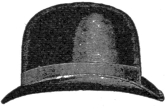
THE "DERBY" OF 1889.
No. 13.
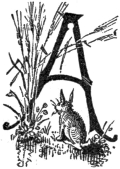
A STRANGE fact is that the Civil War, so disastrous in its effect upon
the industries of Baltimore, was followed at its close by the rise of
a new enterprise, of manufacturing straw hats, which so increased and
extended that in number of establishments and volume of production it
soon outrivalled those of fur hats in their most prosperous time, thus
securing to this city a kindred business, greater in extent and
importance than the one which had, by force of circumstances, been
wrested from her. The good reputation which the products of the new
industry has acquired in every part of the country has contributed not
only to the prosperity of the city, but has assisted by adding credit
for the high standard of its manufactured goods.
In the year 1866 Mr. G. O. Wilson and Mr. Albert Sumner left their homes in Foxboro, Mass., in search of a95 promising field for establishing the business of renovating straw hats. Without any definite place in view, one city after another was visited, Baltimore being finally their chosen locality. Messrs. Wilson & Sumner associated with them Mr. W. C. Perry, who also came from Foxboro, and the firm was made Sumner & Perry, establishing themselves in the rear of No. 71, now 10 West Lexington street.
Mr. Sumner withdrawing from the firm the same year, the two remaining partners continued the business at the same place as the firm of Wilson & Perry. At that time the retail price of straw hats was such as to allow a profitable business to be done in renovating and altering styles, and in that branch these persons met with success.
Previous to this, however, others had been engaged in the business of bleaching and pressing straw hats. Among the first who entered into the business, as far as can be learned, was the firm of Rosenswig, Davidson & Ash, about the year 1848; they were cap manufacturers, and added the pressing of Leghorn hats as an auxiliary business. Mr. Samuel White, who learned his trade of the previously mentioned firm, afterwards carried on hat bleaching and pressing in connection with cap making, at No. 78 South Charles street (present No. 132). From 1850 to 1865 extensive importations of German straw hats came into96 the port of Baltimore, and Mr. White did a large business in finishing these goods. In 1857 Mr. White commenced the jobbing hat business, forming in 1861 the firm of White, Rosenburg & Co., and is now in business at No. 9 South Howard street, of the firm of S. White & Son.
Richard Hill, at present in the retail hat business at No. 5 South Liberty street, was formerly engaged in hat bleaching and pressing at the same locality.
Messrs. Wilson & Perry continued to prosper in their enterprise, and, increasing their facilities, gradually developed it into straw goods manufacturing, confining their business for several years almost exclusively with two prominent Baltimore jobbing houses, who supplied sufficient patronage for their constantly increasing production; one of their patrons being Cole, Brigham & Co., the other Armstrong, Cator & Co., one of the largest millinery firms in the country.
In 1877 Messrs. Wilson & Perry purchased the premises No. 101 West Lexington street, now 104, where they secured more commodious quarters, and, with an admirably equipped factory, continued to do a large and prosperous business. Mr. Perry died in 1880. In July, 1887, the firm title of Wilson & Perry was changed, Mr. Wilson associating with M. Frank, J. D. Horner and A. Levering, formed the firm of Wilson, Frank & Horner,97 and occupied the warehouse No. 204 West Baltimore street, in connection with the factory on Lexington street.
In January, 1875, Isaac H. Francis and James E. Sumner, who had been in the employ of Wilson & Perry, started the straw hat manufacturing business at the N. W. corner of Lexington and Liberty streets, and in the following year Wm. T. Brigham (then of the firm of Cole, Brigham & Co.) became associated with them, the firm being made Francis, Sumner & Co. In 1877 the firm of Cole, Brigham & Co. was dissolved, Mr. Brigham becoming connected with R. D. Hopkins, as the firm of Brigham & Hopkins, occupying the premises No. 128 West Fayette street (present No. 211). In 1880 Mr. Hopkins was admitted as a partner in the firm of Francis, Sumner & Co., and Messrs. Francis and Sumner became members of the firm of Brigham & Hopkins, the interests of the two firms having always, in fact, been identical since they were first established. The two firms were continued until July, 1887, when, by the withdrawal of Mr. Sumner, they were dissolved, and became consolidated as the firm of Brigham, Hopkins & Co., now occupying the large and spacious factory at the corner of German and Paca streets, erected in 1884.
In the year 1880 Messrs. Francis, Sumner & Co. placed their interest in their Lexington and Liberty street98 factory with Wm. Fales and Jas. M. Hopkins, transferring their own entire business to the enlarged premises at 128 W. Fayette street. Fales & Hopkins continued at the corner of Lexington and Liberty streets until the fall of 1883, when Mr. Hopkins, forced by declining health to give up business, sold his interest to Mr. Louis Oudesluys, the firm becoming Fales & Oudesluys. Mr. James M. Hopkins died of consumption at Colorado Springs, February, 1884.
In 1885 S. C. Townsend and John W. Grace became associated with Messrs. Fales & Oudesluys, and a new firm formed, as Fales, Oudesluys & Co., continuing for two years, when it was dissolved, Messrs. Townsend and Grace remaining as the firm of Townsend, Grace & Co., at 128 W. Fayette street, while Messrs. Fales and Oudesluys formed a new firm, as Fales, Oudesluys & Co., locating at 115 S. Eutaw street. Mr. Fales remained in the latter firm but a few months, when it was again changed to that of Oudesluys Bros., comprised of Louis, Adrian and Eugene Oudesluys, now doing business at 115 S. Eutaw street.
In 1878 Mr. M. S. Levy, who was then a cap maker, commenced the finishing of straw hats, having the hats sewed by others, while he did the finishing and trimming, his place of business being then at the N. E. corner of Sharp and German streets.
With increasing trade, Mr. Levy removed in 1881 to more spacious quarters at Nos. 318 and 320 W. Baltimore street (present numbers 216 and 218), where he commenced the general manufacture of straw hats. In 1883 he took his two sons into partnership, the firm being made M. S. Levy & Sons; their premises being destroyed by fire in October, 1886, they removed to 117 S. Sharp street. In September, 1888, being again the victims of fire, they occupied temporarily the premises N. E. cor. Paca and German streets, remaining there until taking possession of their present extensive factory located at the N. W. cor. of Paca and Lombard streets.
In 1880 Tomz, Richardson & Co. commenced in a small way to manufacture straw hats at No. 341 W. Baltimore street (now 317), but, from lack of business experience, soon abandoned the undertaking.
Messrs. Bateman & Richardson in 1882 embarked in the business, occupying a portion of the premises No. 5 S. Liberty street. In 1883 Mr. Scutch was admitted as a partner, the firm becoming Bateman, Richardson & Co., and, removing to No. 55 St. Paul street (now 313), continued until 1885; not meeting with anticipated success, they gave up the business.
Messrs. Francis O. Cole & Co. in 1882 commenced the manufacture of straw goods, erecting for the purpose100 a building at Nos. 7 and 9 Saratoga street (now 424 E. Saratoga), continuing business until 1885, when the firm was dissolved.
Mr R. Q. Taylor has long been engaged in the manufacture of Mackinaw straw hats as a specialty. His acquaintance with and interest in this product dates as far back as 1850, when he first used the Mackinaw for his retail trade, since which, every season the "Mackinaw" has been the prominent straw hat sent from his establishment, and for a period of fifteen years was the only article of straw hat retailed by him. The successful control of a special style as an article of fashion for thirty-five consecutive years is a remarkable record, an accomplishment that plainly shows ability as a leader of fashion, for which Mr. Taylor's natural capacity so well fits him.
Mr. Taylor confined the use of the "Mackinaw" hat strictly to his retail demands until after the year 1868, since when he has manufactured the article for the trade, distributing his products over the entire country, and establishing for "Taylor's Mackinaws" a national fame.
In addition to the manufacture of men's and boys' straw hats, which class has heretofore comprised the larger proportion of such goods made in Baltimore, another branch, that of ladies' straw goods, has been developed, and is already assuming interesting proportions, promising to become a valuable addition to this industry.
Messrs. Wolford & Shilburg in 1883 commenced the manufacture of ladies' straw goods at No. 6 E. Pratt street, remaining at that place for one year, removing in 1883 to No. 205 Camden street, where they are now located.
In 1887, Messrs. L. W. Sumner, G .K. Thompson and D. Whitney, as the firm of Sumner, Thompson & Whitney, commenced the manufacture of ladies' and misses' straw goods, locating their factory at 317 N. Howard street.
At the present time there are in Baltimore, apparently in prosperous condition, eight straw hat establishments, giving employment to eleven hundred hands, male and female, and producing annually, manufactured goods to the value of upwards of a million dollars, in the distribution of which Baltimore is brought into close business contact with every State and Territory of the Union, and the city's importance as a manufacturing centre is enhanced by the character of articles sent forth by those engaged in this class of business.

No. 14.
FOR many years the Mackinaw took precedence of all straw hats as the most desirable summer article for gentlemen's headwear, far out-rivalling in its success as a fashion any other straw product ever introduced to the American people. Having attained this prominent position mainly through its successful management by Baltimore manufacturers, it forms an important factor in the prosperity of the straw hat industry of Baltimore. In fact it is the actual foundation of the present large and increasing straw goods business of the city to-day.
While the Mackinaw hat had previously found favor with a few prominent retailers, it was not until the year 1868 that Mr. W.T. Brigham, then of the firm of Wm. R. Cole & Co., observing the merits of the article, concluded to undertake its introduction to the trade, to whom it was generally quite unknown. Among those who had used profitably the Mackinaw for their retail trade were R.Q. Taylor, of Baltimore, Charles Oakford, W.F.103 Warburton and Louis Blaylock, of Philadelphia. Though it was an article of domestic production, the beauty and commendable qualities of the Mackinaw were indeed a surprising revelation to the trade at large. Each year added to the popularity of the Mackinaw, until it became the acceptable American straw hat, without which no first-class retailer could consider his stock complete. While the great demand existed, Baltimore continued to supply the larger proportion of all the Mackinaw hats sold, and taking advantage of the reputation thus gained for such goods, her manufacturers produced other kinds of straw hats, and by the exercise of proper care and attention acquired such skill as to secure for the straw goods products of Baltimore the worthy reputation of being the best made in the United States, consequently and beyond contradiction the best in the world.
In the earliest days of straw hat making in Baltimore, at the time when the Mackinaw was being introduced, the sewing of straw hats by machine was a new invention, and practically a close monopoly controlled by a strong combination of wealthy straw goods manufacturers of the North, who, jointly as a stock company, prevented the sale of the straw sewing machines outside their own circle. Fortunately for the success of the new undertaking in Baltimore, the good qualities of the Mackinaw hat were104 more satisfactorily retained by hand sewing, rendering machines in their manufacture a useless requirement.
Thus an advantage was gained in supplying a hand-sewed hat, embodying such points of perfection in style and finish as to quite surprise those not familiar with the manufacture of such goods. The "Mackinaw" of Baltimore make continued to grow in popular favor until it had secured a greater distribution than was ever before attained by any other article of straw hat, making a remarkable record for tenacity, by holding for upwards of fifteen successive years, popularity as the leading article of summer headwear.
Baltimore continued to enlarge and increase her straw hat factories and improve their products, so that now in this industry she stands in the proud position of being the leading city in the United States in the production of the best class of straw hats.
This, in brief, is a history of another branch of the hat business, which attained large proportions, supplementing the one which, having gained a degree of importance in the manufacturing history of the city, was by force of circumstances reduced to comparative insignificance.
The growth of the straw hat business of Baltimore may be looked upon as somewhat phenomenal. The first introduction of the Mackinaw hat by William R. Cole 105& Co., in 1867, may be taken as the beginning of straw goods manufacturing, and with but a single manufacturing firm existing in 1875, its development and increase dates from that time. It is doubtful if in 1875 the total value of manufactured straw goods produced in Baltimore reached the sum of $75,000, while in the face of a steady and constant decline in values—the result of labor-saving machines, together with reduced cost of raw material—an increase in production of twenty-fold is an accomplishment of less than fifteen years. This success cannot be attributed to any local advantages, but is due entirely to the energy, enterprise and business qualifications of those engaged in the business, qualifications which have accomplished the result of giving valuable assistance in the city's advancement as an important manufacturing centre. It has also, by the recognized merits of its products, lent a worthy influence throughout the whole United States in sustaining the excellent reputation long enjoyed by Baltimore for the good quality and reliability of its manufactured goods.
No. 15.
A RESULT of the remarkable popularity of the Mackinaw straw hat was, that Baltimore came rapidly forward as a straw goods manufacturing place, becoming important as a center in that particular branch of business; therefore a history of the article which contributed so largely to the development of this industry is likely to prove both interesting and instructive.
"Mackinaw," as a trade term or name, does not, as might be supposed, indicate the region from whence the articles comes, but undoubtedly received its christening from some one of the few retailers who early used these goods, in order to create a distinction from a similar, but107 much inferior article, then termed the "Canada" hat. While both the "Mackinaw" and the "Canada" are made of wheat straw, the difference between the two, as the product of one country and of nearly the same latitude, is a great surprise. The wheat of the eastern part of Canada produces a straw dark in color, harsh in texture, and of little use for making a hat, while that grown in the western part of the same country is clear and white in color, possessing a brilliant enamel which imparts the beauty that rendered the Mackinaw so famous as an article of fashion.
The Mackinaw must be considered a local rather than a national production, coming as it does from a region comprised within a small radius around the city of Detroit, part of which is Canadian territory and part within the borders of the United States; for while considerable straw from which the plait is made is raised and plaited within the limits of the State of Michigan, by far the largest proportion, as also the best quality, is the product of the Canadian territory. Nature seems to have provided a small community with unusual advantages, for within a limited territory has been produced all the large quantity of straw plait required to supply the popular demand that for many years existed for Mackinaw hats, and all efforts elsewhere to produce material combining the peculiarities of this straw, from which these hats were made, invariably failed.
The claim of the Mackinaw to antiquity and long use is perhaps as strong as that of other plaits with which the trade has become familiar, for no doubt the natives of the country made use of these hats as a head-covering long before they became an article of trade.
The Mackinaw was for many years after its first introduction sold under the designation of the "Canada" hat, the name given to a similar but comparatively degraded article produced in Lower, or Eastern Canada; and the title Mackinaw was first applied by the late Mr. Charles Oakford, of Philadelphia, or by Mr. R.Q. Taylor, of Baltimore, each of whom were among the first to make it a fashionable hat.
The makers of these goods are wholly the poor, ignorant half-breeds, who spring from the Canadian French and the Indian. Finding that hats, as well as the skins of the animals they trapped, could be traded for, the family talent was brought into use to produce something that might contribute to their meagre subsistence. So during the winter season, while the men hunted the muskrat, the Indian women and children plaited straw and made hats, which, on the opening of spring, were carried with the skins obtained by the hunters, to the towns, where they were exchanged for food, drink, clothing and ammunition.
To the advantages of soil and climate is attributed that109 purity of color, brilliancy of enamel, toughness of fibre and elasticity of texture which are recommendations of the Mackinaw. Added to these natural qualities was the advantage of a peculiar treatment given to the straw by the natives, who employed a whitening or bleaching process without the use of chemicals, giving increased beauty to the article.
During the prosperity of Mackinaw straw plaiting, a prominent character among the half-breeds was one Madame Lousseux, a sturdy, aged matron, with twelve hearty daughters, who, inheriting their mother's prolific nature, were in turn each the proprietress of a family of a dozen boys and girls. They all appeared to inherit the old lady's natural ability and wonderful expertness, and surpassed all competitors in the plaiting of the straw. The choicest products in braid and hats came from the Lousseux family.
In 1834, and for many years after, these goods were sold and used only as ordinary harvest hats. It now seems surprising that an article possessing such attractive merits should have occupied a secondary position and been so long in establishing the reputation it finally secured. The first person, as far as discovered, who used this article for retail purposes as a genteel and fashionable hat, was Henry Griswold in the year 1845, who did business110 in the then little and obscure town of Racine, Wisconsin. The Raciners must have been people of an appreciative and refined taste, as it appears that Mr. Griswold sold the hat for several seasons to his own advantage.
Prior to 1846 these goods were sold in New York by Leland, Mellen & Co., at that time the largest wholesale hat firm in the country. Mr. Mellen retired from business in 1851. In reply to a personal inquiry of the writer in the year 1874, Mr. Mellen wrote from Framingham, Mass., as follows:
"The Canada straw hat from the region of Detroit was sold by our firm as early as 1845. After being blocked and trimmed, they were sold as an ordinary staple hat. We sold a few to John H. Genin, W.H. Beebe & Co., and Charles Knox, then the leading retail hatters of Broadway. I think, however, they were sold by them only as a fishing or harvest hat. We continued to receive these goods from Detroit for several seasons, until an article from Lower Canada, of inferior quality and less price, made its appearance, and stopped the sale, as far as we were concerned."
The exact date of the appearance of the Mackinaw in Philadelphia cannot be accurately determined, but it must have been as early as 1847. Messrs. Beebe, Coster & Co., a prominent retail firm in Philadelphia, in 1849, sold the111 tapering crown, wide brim "Canada straw hat." From about 1855 to 1860 the Mackinaw became so very popular in the Quaker City that it was recognized as a leading article. The prominent retailers then using it were Charles Oakford, W.F. Warburton, Louis Blaylock, and Sullender & Pascall; each of these firms themselves finished the straw hats, taking them as they were sewed by the natives, which was with a taper crown and wide brim, making little pretence to any variety in style or proportion. Messrs. Sullender & Pascall made an advanced step and undertook one season to sell the Mackinaw to the exclusion of all other straw hats, preparing them in various shapes and for the first time adapting them to the requirements and tastes of a "nobby" trade.
In 1847 William Ketchem of Buffalo, E.B. Wickes of Syracuse, and John Heywood & Sons of Rochester sold these hats. In 1848 L. Benedict & Co., prominent retailers of Cleveland, handled the goods. This firm was followed next season by Messrs. R. & N. Dockstadter, then a very prominent concern in the same place. In 1849 they were sold in Sandusky by C.C. Keech.
The Mackinaw during these periods must have been introduced and sold in other places, but it had not secured its recognition as an article worthy of being placed on a level with foreign productions, which were112 then considered the desirable and suitable straw hat for genteel wear. It was probably not until after the year 1855 that the article received its title of "Mackinaw," and not until then did it secure its well merited, dignified position.
By far the largest retailer of the Mackinaw hat in this country, and the one to whom belongs the greatest credit in popularizing it, is Mr. R.Q. Taylor, of Baltimore. He introduced the hat to his customers as far back as 1850, and for thirty consecutive seasons sold it without any apparent diminution of popularity. For many years Mr. Taylor sold the Mackinaw to the exclusion of all other straw hats. At one time so identified did the Mackinaw become with the people of this city, that it was said a Baltimorean might be recognized anywhere by the straw hat he wore. Mr. Taylor asserts that in the years 1872 and 1873 he retailed from his own counter, in the two seasons, upwards of 9000 hats. The reputation of the Mackinaw has been admirably sustained by Mr. Taylor, whose firm is still engaged in their manufacture, with a constant demand for them. Probably no other straw hat ever introduced to the American public can show such a continued and extended sale. In 1868 Messrs. Wm. R. Cole & Co., predecessors of the present firm of Brigham, Hopkins & Co., commenced to produce these goods for the general trade,113 and it is to their efforts that much of the widespread popularity of the Mackinaw is due. They first tried these hats with their own local trade, and finding them eminently successful, ventured to offer them in New York, meeting with much encouragement. From a small commencement their trade in these goods continued to increase until a large and well established business was secured, continuing to grow in volume and extent, and becoming the precursor of an industry that places Baltimore in a leading position as a manufacturing place for straw goods.

No. 16.
IN the rank of those whose successful undertakings have contributed towards the restoration to Baltimore of a lost industry, and placing it upon such a foundation as to have it recognized as one of importance, no firm stands more prominent or has done more towards its accomplishment than that of Brigham, Hopkins & Co. The straw hat business inaugurated by this firm's immediate predecessors, and encouraged by their own efforts, has grown in volume and strength until Baltimore is now115 designated in trade parlance "the straw hat city," rightfully claiming the honor of surpassing in this class of her manufactured products the efforts of all rivals of this or of any other country.
Messrs. Brigham, Hopkins & Co., while possessing a large business, have the pleasure of conducting it in a spacious building, whose architectural design is one of the handsomest of its kind in the country, and whose conveniences for the successful prosecution of their business cannot be excelled. A business coming from one of its pioneers through a direct succession of firms gives to Brigham, Hopkins & Co. a natural pride in such an inheritance, and brings also a pleasure in being able to trace its progress from its origin, showing how this branch of manufacture was at an early day brought to an admirable condition of prosperity, afterwards to pass through a period of almost total decay, then again to attain a development that entitles it to rank with any of the successful and prominent industries of the city.
It is a pleasant reflection as well as a happy coincidence that the restoration of a forsaken industry, once a vital element in the city's life and activity, is greatly due to the labors of the firm who, in this branch, connect the past with the present, the old with the new.
The enterprising business traits manifested by Runyon116 Harris, in erecting, in the year 1814, a large hat factory in this city, seemed to have prompted his various successors to a spirit of emulation, enabling them to preserve the legacy bequeathed them, and to perpetuate that reputation for meritorious products that was so early earned in the factory of Mr. Harris.
Following the erection of the factory by Mr. Harris came the firm of Aaron Clap & Co., who purchased the property and commenced in 1817 the manufacture of hats, and a remarkable fact—one encouraging an innate pride in their successors—is that during three-quarters of a century all of the firms inheriting a title of descent from that of Aaron Clap & Co. have passed in safety through every financial convulsion of the country, and have promptly met every pecuniary obligation incurred.
Although during the former period of prosperity in the hat business of Baltimore, felt hats only were manufactured, which business was completely reduced by the unfortunate conditions existing at the time of the Civil War; its revival came through the establishing of a different branch, that of the manufacture of straw hats; and while Messrs. Brigham, Hopkins & Co. have lately entered extensively into the manufacture of silk and felt hats also, it is the purpose of this article to dwell more particularly upon facts relating to the straw hat branch that has contributed117 so largely in bringing Baltimore once again forward as a leading hat manufacturing city.
Prior to 1860 Messrs. Wm. P. Cole & Son, then manufacturers and jobbers, became especially interested in the straw goods branch of their business. Being at that time manufacturers of the best class of felt hats, the straw goods sold by them were all made in the factories of the North. Machines for sewing the straw braid were not then in use, and much of the straw products of foreign countries came ready sewed in shapes that were very irregular in proportions and sizes. The looseness of the stitches in sewing rendered the use of glue a necessity in the manufacture of the hats, producing an article of headwear that gave but little comfort. Suggestions for improvements were given the manufacturers, who adopted them with advantage to themselves. The first suggestion made by the Baltimore firm was an improvement in the appearance of the hat by trimming it with wider bands. At that time the use of bands about 14 lines wide was prevalent, and the adoption of 23-line bands was looked upon as a very radical departure. The substitution of leather sweats for those of oil muslin was also first undertaken by the Baltimore firm; following which, the most important improvement ever gained in the production of straw goods was conceived and executed in118 this city, which was the abandonment of the heavy glue-sizing and the manufacture of the comfortable "flexible finish" straw hat, an accomplishment secured by careful attention to the proper sewing of the goods aided by hand finish.
For several years Wm. P. Cole & Son and their successors had straw hats of their own designing made and finished at the North, continuing to suggest improvements which were made at their command, and the privilege of retaining which for their own trade was for the time extended to them by the manufacturers, from which they gained such advantages as would arise from having goods superior to and differing from the general class sold by others.
It was in the year 1875, upon the dissolution of the firm of Cole, Brigham & Co., that Mr. W.T. Brigham and Mr. R.D. Hopkins, uniting as the firm of Brigham & Hopkins, became straw hat manufacturers. The Mackinaw straw hat had at this time gained well in popularity; the natural firmness and flexibility of the Mackinaw were merits particularly acceptable to the trade, and the new firm made a careful study of embodying as far as possible in the manufacture of all their straw hats, those essential points possessed by the Mackinaw. So successful were their efforts that, by the exercise of119 thorough watchfulness, they continued to improve, until they secured for their products a celebrity that gave the firm the foremost position in the trade.
Following the onward movement of the straw hat business in Baltimore since its first introduction (less than twenty years ago), it is interesting to watch its constant and steady growth, and to observe the advance that has been accomplished. Even before Messrs. Brigham & Hopkins entered upon the business, a great improvement in the straw goods had already been made through the favorable impetus imparted by their predecessors. Straw hats which from a lack of style and comfort had heretofore played a secondary part in the conditions of man's costume, were so much improved in style and finish as to be accepted as a desirable article of dress, thus an increased demand was created for them.
To still further improve the straw hat, and as near as possible secure perfection, was the aim of the Baltimore manufacturers.
Entering the field with the commendable object of producing a class of goods that should be recognized as the best, Messrs. Brigham & Hopkins, abandoning traditional ways, commenced their work upon a thoroughly independent basis; copying after none, but relying upon their own ingenuity; striving to improve upon every last120 effort, observing and studying the wants and needs of their customers, they continued to put forth a class of goods bearing an undoubted stamp of originality, which, being supplemented by excellent workmanship and the use of good materials, resulted in securing a large patronage, and brought to them a constantly increasing trade. In this way did the firm secure a recognized position at the head of the straw hat industry of the country, and gained for their products a reputation for excellence in style and finish that is widespread over the whole country. American manufacturers had a long and tedious struggle in their efforts to overcome the prejudices of the people existing in favor of foreign productions, but steady endeavors to win the approval of Americans for American made hats have scored a genuine success, and the American gentleman of to-day may take a just pride in wearing a straw hat of Baltimore make—one not to be excelled.

No. 17.
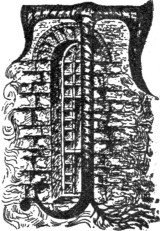
THAT part of the history of Baltimore which relates to the present
position of its hat industry is especially interesting, as it records
a business that has acquired large proportions, placing it prominently
among the many important manufactures of this city.
A business identified with the very earliest days of the city's existence, growing and assuming in its movement a condition of vigor and prosperity that is encouraging for the future, has given to Baltimore a name and fame that places her in an enviable position at the very head of the hat-manufacturing cities of this country.
As an example, showing the growth and progress of the hat business, and giving evidence of its extent in122 Baltimore at the present time, no better illustration could be offered than a description of the complete establishment erected by Messrs. Brigham, Hopkins & Co. for the requirements of their extensive business.

PRESENT FACTORY OF BRIGHAM, HOPKINS & CO.
While at the present time the hat business of Baltimore is largely confined to the special manufacture of straw goods, a revived movement made by one firm in the manufacture of silk and felt hats assures a development of that123 branch of the business also into such proportions that ere long it may restore to Baltimore the prestige and rank it once held as the manufacturing centre of high grades of that class of goods.
Going back to the early period of 1814, Runyon Harris, the predecessor of this firm, in advance of his time displayed evidence of progressive ideas by erecting what was then considered a large and spacious factory. His structure was one hundred and twenty-five feet in length, about twenty-five in width, and two and a half stories high; the area of space upon the two floors, which was alone suited for work-people, was 6200 square feet.
The line of successors to Runyon Harris have all been found proverbially enterprising and energetic, always noted as active and successful manufacturers of their day. Inheriting somewhat the spirit of activity so marked in their worthy predecessors, Messrs. Brigham, Hopkins & Co. are found in the advance, and make no idle boast of an establishment whose breadth of space, architectural beauty, and convenience of arrangement find few rivals in the whole catalogue of similar business places in this country. Their warehouse, prominently situated, rising six stories above ground, being one hundred and fifty feet deep by forty in width, gives a surface area of 42,000 square feet of work room, all of which is provided with unusual advantages124 for daylight and ventilation. Added to this is the detached "make-shop" of the firm, located at Relay Station, on the line of the Baltimore and Ohio Railroad, nine miles from the city.[2] It is a high studded building, of one story, built in this manner to allow the condensing and evaporation of steam, which escapes from the "batteries" of boiling water, around which the men are constantly at work. This building is one hundred and thirty by sixty feet, giving in addition to the city ware125house 7800 square feet, or a total in round numbers of 50,000 square feet, upwards of an acre of working space, which is a good showing of growth and expansion when contrasted with one of the best establishments of the year 1814.
[2] This department has lately been removed to the city, and is located corner Paca and King streets.

The handsome structure at the corner of German and Paca streets was erected by Messrs. Brigham, Hopkins & Co., designed and arranged to suit the demands of their own manufacturing business. Ground was broken in the month of April, 1884, and the building completed and occupied in January, 1885. It has a frontage of forty-one feet six inches on German street, and extends back on Paca street one hundred and fifty feet to Cider Alley.
Located upon one of the broadest thoroughfares, at a point which is the water-shed of this part of the city, being at the level of one hundred feet above tide-water, it rises prominently among other fine warehouses surrounding it, showing its array of architectural beauty to advantage, for it is one of the most imposing of the mercantile structures of the city. The building is constructed of Baltimore pressed brick and the famous Potomac red sandstone, which together so harmonize in color as to render a very pleasing effect; the ornamentations surrounding the windows are in terra-cotta and moulded brick. The style of the building is Romanesque, or round126 arched. Very striking features are the immense arched openings upon the Paca street façade, being seventeen feet in width and twenty-five feet in height, which with their broad treatment of mullioned panels and heavy rough-hewn stonework, give strength and character to the building. These spacious windows are not simply for effect, but designate the location of the principal offices, and by their wide expanse afford abundance of light to the show-rooms, making these departments particularly attractive by the cheerful airiness and brightness that plenty of sunlight always brings.

The large office windows.
Throughout the whole building is a generous treatment of spacious windows, flooding the interior with a bountiful supply of light, so necessary to the production of properly127 manufactured goods as well as to the health and comfort of the work-people.
The main entrance to this building is marked by its liberal dimension. A slight elevation is made from the sidewalk, and beyond a recess of several feet are framed two large French plate glass windows, which afford a view of the entire extent of the first floor with its offices and extensive storage room. Entrance doors are placed on either side of this recess.
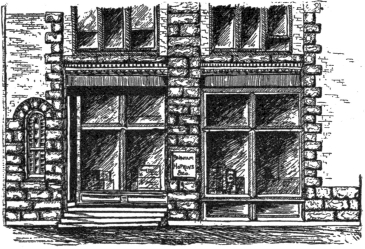
THE FRONT ENTRANCE.
Broad stairways connect every floor, providing easy and quick ingress and egress at both the front and the back part of the building, rendering in the greatest degree security to the lives of those employed within.
Adjoining, in the rear, is another structure three stories high, separated from the main building by fire-proof brick walls, and used as a boiler-room, as also for other departments of work desirable to be kept apart from the general work-rooms. This separate building was designed as an additional means of safety, in not having the large boilers within the limits of the main building.
From basement to roof this model factory is well equipped with all necessary modern plans for producing the best that is capable of being made in this manufacturing line.
No. 18.
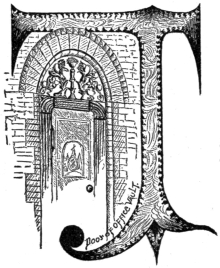
TAKING the start for a tour of inspection through the establishment of
Brigham, Hopkins & Co., one is ushered directly into the first or main
floor of the building, which is partly occupied by offices for the
members of the firm and for the necessary clerical force, as well as
the show-rooms for the exhibit of the products of this factory. These
various apartments are partitioned off with handsomely beaded cherry,
and a series of arched windows give beauty to the architecture and
serve the practical purpose of ventilation.
The several rooms upon this floor are handsomely finished in solid cherry; this was done solely with the view of harmonizing the effect with that of the exterior of the building, rather than for an indulgence in luxury.
In the first office is a capacious fire-proof vault, having its counterpart in size in the basement, upon which the one in the office rests; it is built of yellow enameled-face brick, and with its handsomely finished iron door surmounted with a bold decoration in terra-cotta, adds greatly to the ornamentation of this room. The desks are all of cherry, large and capacious, designed expressly for the required accommodation of the bookkeepers.
Adjoining is the private office of the members of the firm; among the decorations of this room is a spacious open fire-place, ornamented with terra-cotta tile and a handsome mantelpiece in carved cherry. The carpeted floor and tasty furniture serve to give that comfort that is looked for in the modern office of the business man. Beyond and leading from this office are show-rooms for the exhibition of the firm's products. These show-rooms, two in number, are without doubt the best in finish, breadth of space and arrangement of any in this branch of business in the United States, affording the best conveniences for the display of the handsome goods they contain; the first in size, 25 x 18 feet, with an adjoining one 131 18 x 12 feet, is supplied with handsomely designed show-cases of solid cherry and of glass; the wall space is colored a light tint, while the ceilings are laid off in yellow and brown. A long table of cherry occupies the centre of the large room, while the hard-wood floors are partially covered with oriental rugs. When these rooms are filled with the132 choice products of the firm, embracing the finest qualities of straw, with their trimmings of various hues and colors, intermingled with the sombre black of the derbys and the brilliant lustre of the silk hat, upon which is thrown a bountiful supply of light that comes from the spacious windows, a striking melange of harmonious colors is produced. Here the customer is surrounded by all that is desired from which to make his selection.
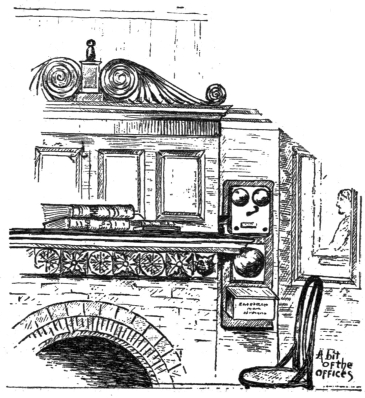
A bit of the offices
Beyond these show-rooms is still another room devoted to the valuable collection of hat trimmings. While to the uninitiated the trimmings of a hat, consisting merely of its band and binding, may appear quite insignificant, yet to the manufacturer it is a part of great importance. Here in this room, stored in various quantities, are two hundred different designs of hat-bands, every one of which is the product of a French or German loom, mostly made from original designs furnished and sent abroad to be executed for this firm.
From this, the last of the series of departments on this floor, exit is gained to the remaining space, which is used for the packing and storing of goods ordered and received finished from the factory.
With an ascent to the second floor by a broad stairway, the "finishing" department of silk and fur hats is entered; this department occupies the entire space of this floor.133 Here the silk hat is made and finished complete, and the derby, whose process of manufacture belongs to several departments, receives its finishing touches, of curling and setting the brim, after which it is neatly nested in tissue paper and placed in paper boxes to be sent to the packer.
The third floor provides three departments: that of silk and felt hat trimming, straw hat trimming department, and that very valuable and necessary auxiliary to business, the printing department. Although two branches of the hat business are carried on under the same roof (that of straw and that of silk and felt hats), they are kept entirely separate and distinct in all their requirements and details, which affords a reason for the difference in aspect of the trimming departments on this floor. In one, the multitude of busy hands is at work upon hats of black, while in the adjoining department, the many nimble fingers are handling the light and delicate straw and the bright ribbons, making a contrast of the sombre with the gay.
Entering the next department, we find that element of development, that force of propulsion by means of which modern business plans are moved and executed—the printing press. This department is fitted and furnished complete with such requirements as are necessary to the advance of an enterprising business. A large Gordon press, propelled by steam power, is kept constantly in use to134 supply the vast amount of printing required in the details of this business. Tips, labels, size-marks, tickets for use in the various departments of "making," "sewing," "sizing," "finishing," and "blocking." Order tickets, coupons, boxes and box labels and mercantile printing are but a portion of the work done here. In addition, a patent gas-heating press is used for printing in gold and silver leaf. There also emanates from this department a monthly trade journal, conducted under the auspices of the firm.
Ascending to the fourth floor, the noisy sound of machinery is first heard. This is the department for sewing straw braid; here unquestionably centres the interest in a hat factory; the hum of a hundred machines quickens the pulse, and to the observer, the interest and astonishment increases as the wonderful machine with its lightning speed, guided by the magic touch of the young woman who rules it, draws towards itself yard after yard of the delicate strand of straw plait which it sews together by the finest stitch of the most slender thread, till suddenly a hat comes forth, complete in its full perfection of shape. One's surprise would not be more greatly heightened by a display of the magician's art. The marvel of this accomplishment may be effectively demonstrated by a simple statement. That bit of mechanism occupying a space of 10 x 12 inches, with its135 apparently simple arrangement of levers and cogs, merely carrying a needle to and fro, up and down, will do in a single minute the work an industrious woman with her unaided fingers could not do in less than an hour. That little machine is capable of doing within the working hours of a day the labor of sixty women; while a hundred machines in a factory are capable of producing the handwork of six thousand people; this shows the progress of136 the world, and the advance that has come to this branch of industry within the last thirty years.
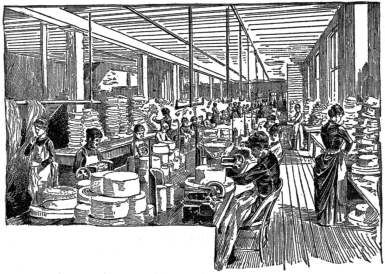
SEWING DEPARTMENT.
Straw braid preparatory to being sewed is wound upon reels, from which it is easily fed to the sewing machine; this department of winding and reeling is also located upon this floor.
Adjoining is the machine room. This department is not only the hospital for invalid and incapacitated machines, where they receive the treatment required to put them in suitable working condition, but its field of usefulness is extended to the making of much of the required machinery, implements and various tools used throughout the establishment.
Another flight of stairs and the fifth floor is reached. This is the straw hat pressing department, occupied entirely by men. Here are the more weighty evidences of labor and work. Heavy and powerful hydraulic presses are used in shaping the ordinary kinds of straw hats, and the necessary metal moulds that form the "dies" for these machines represent tons of zinc. Also in this room is row after row of benches, equipped for that special branch of "hand-finish," which has so greatly assisted in the reputation of the straw hats sent from this establishment. These benches each accommodate six workmen, are supplied with a labor-saving appliance of great merit, the137 invention of one of the firm's employees and at present in use only in this factory, which is, that by means of rubber tubes a combination of gas and air is carried into the pressing irons, by which heat is regulated to any required degree. The advantage of this may be realized when it is known that heretofore these press-irons were heated by "slugs" or pieces of iron or steel, which, drawn from the furnaces of anthracite coal fires, were encased in the hollow irons. By this new invention a remarkable saving is made, by the abandonment of the furnace, in the coal necessarily used, also in the not insignificant matter of time consumed138 by the presser in the constant replenishing of "slugs." Its work is acceptable to the workman and desirable for securing an improvement to the goods.
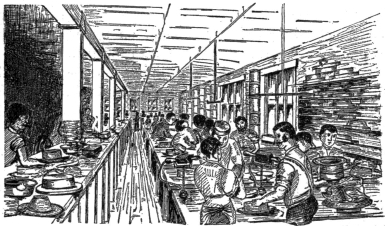
STRAW HAT FINISHING DEPARTMENT.
The next, the sixth floor, has a department of both the straw and felt hat branches of the business. The finishing department of felt hats is a large room 150 by an average of 25 feet, closely studded on three sides with large windows, which at this height throw upon the workmen an unobstructed flood of light, affording unusual advantages for the most thorough perfection in the finish of these goods. This room has capacity for one hundred finishers, allowing generous space for each, giving the convenience and comfort that but few factories afford their work-people.
Adjoining is the department of bleaching and dyeing of straw plaits. This department is supplied with all the modern conveniences for securing the best results. Large wooden vats receive the straw plaits for a thorough cleansing before it is ready for manufacture. Bleaching tubs are near at hand, and large copper vats with all the required steam attachments for dyeing the many desired colors are here conveniently arranged.
Ascending still another flight of stairs, the drying department is reached; this is the most spacious of all the many divisions of this establishment, for it has the sky for a139 ceiling and unlimited space, being virtually upon the roof. Here, ninety feet from the ground, is carried on one of the important divisions of the straw hat business. Two large rooms, really houses in themselves, are built upon this roof; these are the bleach houses, which are provided with artificial stone floors, rendering them thoroughly secure from the chance of ignited brimstone coming in contact with any part of the woodwork of the building. The remaining space upon the roof, equal in its extent to two good-sized city building lots, is secured around and over by a substantial wire netting. Within this enclosure the hats and straw braids coming from the bleaching and dyeing departments are dried.
Ascent has been provided by stairways leading from the front part of this building; descent is also had by the rear, where broad stairs are partitioned off from the work-rooms, making a continuous spacious hallway from top to basement—a wise precaution, taken in consideration of the safety of the lives of those employed. This building, capable of accommodating six hundred work-people, is provided with the most convenient means of escape in case of fire by these broad stairways at each end of the building.
As additional precaution for safety, the boilers supplying the required steam for the various departments, as well as for the motive power and heat, are in a building adjoining140 the main one, but separated by a fire-proof brick wall, and is only accessible by entrance from the outside; here are located two boilers, with a combined capacity of one hundred horse power. Above this boiler-room are two departments desirable to be kept apart from the others; these are the moulding and casting departments, in one of which is made the vast number of plaster shapes and blocks required in the factory, and some idea may be gained of the quantity when it is here mentioned that this department converts annually two hundred barrels of plaster of Paris into hat blocks.
In the casting department are the necessary melting furnaces and other requisites for casting metal "dies," parts of machinery, and the various things needed in a large manufacturing business.
Two large freight elevators, reaching from basement to roof, each of one ton capacity and propelled by steam power, are placed in the building. These elevators are furnished with automatic attachments by which as they ascend and descend each of the floors open and close, thus avoiding permanent openings, the frequent cause of accidents and assistance in the spread of a conflagration; an additional small elevator gives the convenience of transmitting light packages to and from every floor.
Electric bells and tubes afford telephonic communication141 with every department. Steam heat radiates throughout the entire building, and a reel of hose attached to a water supply pipe is in readiness upon each floor in case of fire. The length of steam, gas, and water pipes throughout the building is estimated at five miles. The telegraph call-box signals for the messenger, and the telephone, aids in the execution of the advanced method of reducing the detailed requirements of a large business to a perfectly controllable system in its management.
The engine supplying the motive power for this establishment is located in the basement. With exception of this room, partitioned off for the engine, the entire space of the basement of this large building is used for receiving and storing raw materials used in the manufacture of both straw and fur hats. Here the visitor's imagination may indulge in a wide scope, and his thoughts wander away to many foreign lands, for in this store-room are found the products of nearly every country in the world. China is seen in its strong and durable straw plaits; Japan, a new and formidable rival, shows its handsome goods; far-off India contributing its products, while England, France and Belgium send their choice plaits; Italy, Germany, and Spain are represented, as also South America, Canada, and our own United States, while the Hawaiian Islands make a pretence at competition with the world in142 the making of straw plaits, by submitting creditable specimens of their native products. Furs for making derby hats are also here, sent by Russia, France and Germany. In observing the firm's connection with countries quite encompassing the entire globe, some idea of the extent of this business may be realized.
Thus a fair description is here given of a thoroughly equipped hat factory existing in Baltimore, in the year eighteen hundred and eighty-nine, and the reader may realize by comparison the advance of improvement from the last decade of the eighteenth century to the commencement of the last decade of the nineteenth century.
THE END.
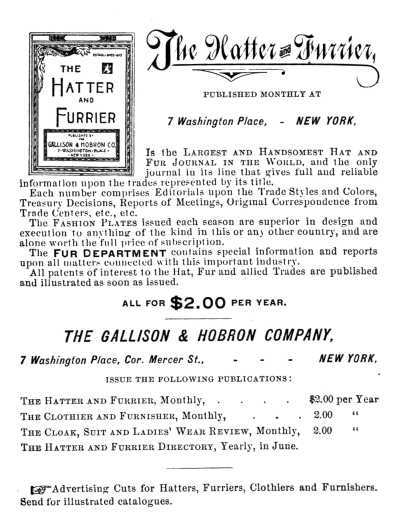
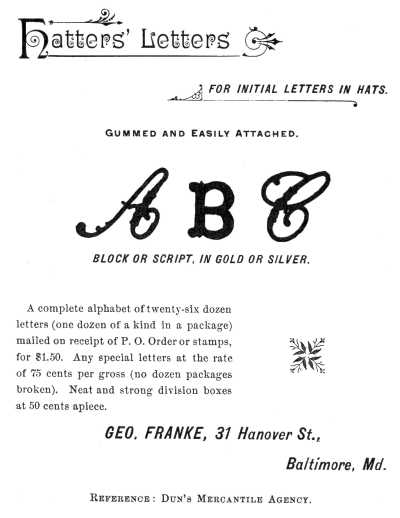
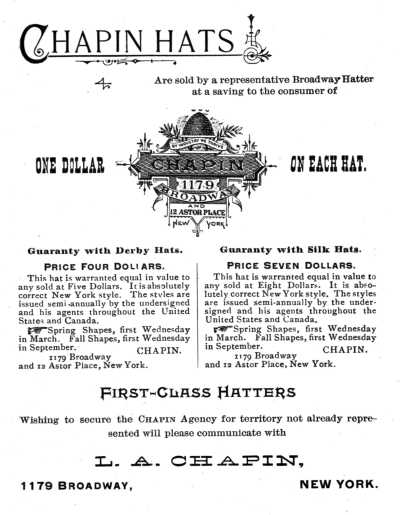
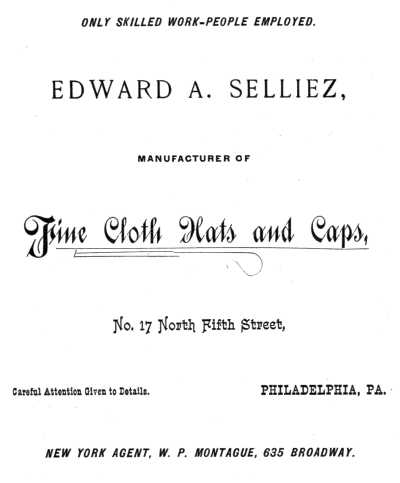
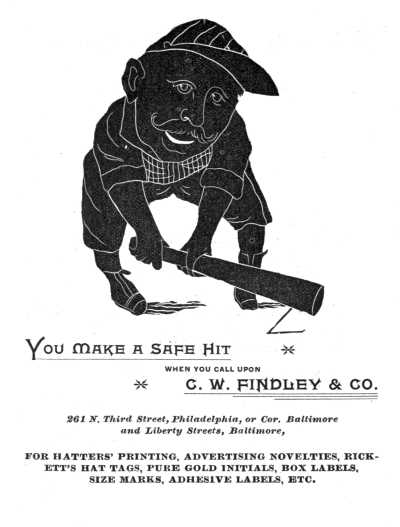

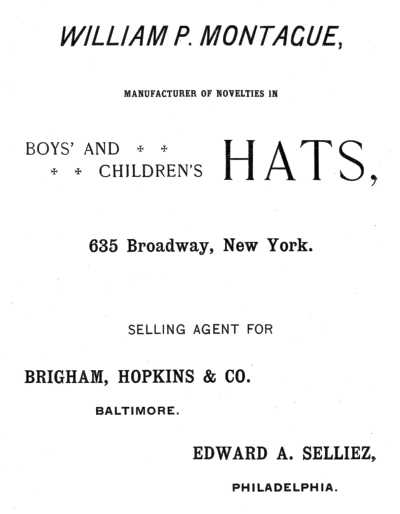
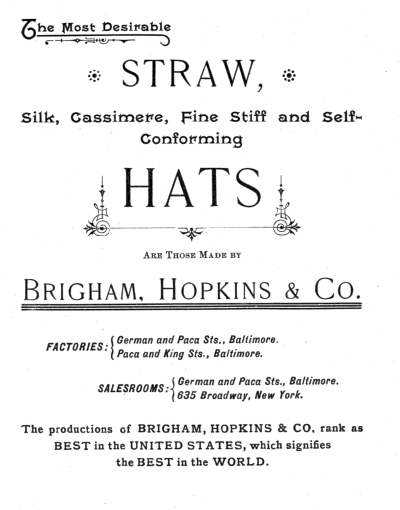
End of the Project Gutenberg EBook of Baltimore Hats, by William T. Brigham
*** END OF THIS PROJECT GUTENBERG EBOOK BALTIMORE HATS ***
***** This file should be named 39780-h.htm or 39780-h.zip *****
This and all associated files of various formats will be found in:
http://www.gutenberg.org/3/9/7/8/39780/
Produced by Bethanne M. Simms, Matthew Wheaton and the
Online Distributed Proofreading Team at http://www.pgdp.net
Updated editions will replace the previous one--the old editions
will be renamed.
Creating the works from public domain print editions means that no
one owns a United States copyright in these works, so the Foundation
(and you!) can copy and distribute it in the United States without
permission and without paying copyright royalties. Special rules,
set forth in the General Terms of Use part of this license, apply to
copying and distributing Project Gutenberg-tm electronic works to
protect the PROJECT GUTENBERG-tm concept and trademark. Project
Gutenberg is a registered trademark, and may not be used if you
charge for the eBooks, unless you receive specific permission. If you
do not charge anything for copies of this eBook, complying with the
rules is very easy. You may use this eBook for nearly any purpose
such as creation of derivative works, reports, performances and
research. They may be modified and printed and given away--you may do
practically ANYTHING with public domain eBooks. Redistribution is
subject to the trademark license, especially commercial
redistribution.
*** START: FULL LICENSE ***
THE FULL PROJECT GUTENBERG LICENSE
PLEASE READ THIS BEFORE YOU DISTRIBUTE OR USE THIS WORK
To protect the Project Gutenberg-tm mission of promoting the free
distribution of electronic works, by using or distributing this work
(or any other work associated in any way with the phrase "Project
Gutenberg"), you agree to comply with all the terms of the Full Project
Gutenberg-tm License available with this file or online at
www.gutenberg.org/license.
Section 1. General Terms of Use and Redistributing Project Gutenberg-tm
electronic works
1.A. By reading or using any part of this Project Gutenberg-tm
electronic work, you indicate that you have read, understand, agree to
and accept all the terms of this license and intellectual property
(trademark/copyright) agreement. If you do not agree to abide by all
the terms of this agreement, you must cease using and return or destroy
all copies of Project Gutenberg-tm electronic works in your possession.
If you paid a fee for obtaining a copy of or access to a Project
Gutenberg-tm electronic work and you do not agree to be bound by the
terms of this agreement, you may obtain a refund from the person or
entity to whom you paid the fee as set forth in paragraph 1.E.8.
1.B. "Project Gutenberg" is a registered trademark. It may only be
used on or associated in any way with an electronic work by people who
agree to be bound by the terms of this agreement. There are a few
things that you can do with most Project Gutenberg-tm electronic works
even without complying with the full terms of this agreement. See
paragraph 1.C below. There are a lot of things you can do with Project
Gutenberg-tm electronic works if you follow the terms of this agreement
and help preserve free future access to Project Gutenberg-tm electronic
works. See paragraph 1.E below.
1.C. The Project Gutenberg Literary Archive Foundation ("the Foundation"
or PGLAF), owns a compilation copyright in the collection of Project
Gutenberg-tm electronic works. Nearly all the individual works in the
collection are in the public domain in the United States. If an
individual work is in the public domain in the United States and you are
located in the United States, we do not claim a right to prevent you from
copying, distributing, performing, displaying or creating derivative
works based on the work as long as all references to Project Gutenberg
are removed. Of course, we hope that you will support the Project
Gutenberg-tm mission of promoting free access to electronic works by
freely sharing Project Gutenberg-tm works in compliance with the terms of
this agreement for keeping the Project Gutenberg-tm name associated with
the work. You can easily comply with the terms of this agreement by
keeping this work in the same format with its attached full Project
Gutenberg-tm License when you share it without charge with others.
1.D. The copyright laws of the place where you are located also govern
what you can do with this work. Copyright laws in most countries are in
a constant state of change. If you are outside the United States, check
the laws of your country in addition to the terms of this agreement
before downloading, copying, displaying, performing, distributing or
creating derivative works based on this work or any other Project
Gutenberg-tm work. The Foundation makes no representations concerning
the copyright status of any work in any country outside the United
States.
1.E. Unless you have removed all references to Project Gutenberg:
1.E.1. The following sentence, with active links to, or other immediate
access to, the full Project Gutenberg-tm License must appear prominently
whenever any copy of a Project Gutenberg-tm work (any work on which the
phrase "Project Gutenberg" appears, or with which the phrase "Project
Gutenberg" is associated) is accessed, displayed, performed, viewed,
copied or distributed:
This eBook is for the use of anyone anywhere at no cost and with
almost no restrictions whatsoever. You may copy it, give it away or
re-use it under the terms of the Project Gutenberg License included
with this eBook or online at www.gutenberg.org
1.E.2. If an individual Project Gutenberg-tm electronic work is derived
from the public domain (does not contain a notice indicating that it is
posted with permission of the copyright holder), the work can be copied
and distributed to anyone in the United States without paying any fees
or charges. If you are redistributing or providing access to a work
with the phrase "Project Gutenberg" associated with or appearing on the
work, you must comply either with the requirements of paragraphs 1.E.1
through 1.E.7 or obtain permission for the use of the work and the
Project Gutenberg-tm trademark as set forth in paragraphs 1.E.8 or
1.E.9.
1.E.3. If an individual Project Gutenberg-tm electronic work is posted
with the permission of the copyright holder, your use and distribution
must comply with both paragraphs 1.E.1 through 1.E.7 and any additional
terms imposed by the copyright holder. Additional terms will be linked
to the Project Gutenberg-tm License for all works posted with the
permission of the copyright holder found at the beginning of this work.
1.E.4. Do not unlink or detach or remove the full Project Gutenberg-tm
License terms from this work, or any files containing a part of this
work or any other work associated with Project Gutenberg-tm.
1.E.5. Do not copy, display, perform, distribute or redistribute this
electronic work, or any part of this electronic work, without
prominently displaying the sentence set forth in paragraph 1.E.1 with
active links or immediate access to the full terms of the Project
Gutenberg-tm License.
1.E.6. You may convert to and distribute this work in any binary,
compressed, marked up, nonproprietary or proprietary form, including any
word processing or hypertext form. However, if you provide access to or
distribute copies of a Project Gutenberg-tm work in a format other than
"Plain Vanilla ASCII" or other format used in the official version
posted on the official Project Gutenberg-tm web site (www.gutenberg.org),
you must, at no additional cost, fee or expense to the user, provide a
copy, a means of exporting a copy, or a means of obtaining a copy upon
request, of the work in its original "Plain Vanilla ASCII" or other
form. Any alternate format must include the full Project Gutenberg-tm
License as specified in paragraph 1.E.1.
1.E.7. Do not charge a fee for access to, viewing, displaying,
performing, copying or distributing any Project Gutenberg-tm works
unless you comply with paragraph 1.E.8 or 1.E.9.
1.E.8. You may charge a reasonable fee for copies of or providing
access to or distributing Project Gutenberg-tm electronic works provided
that
- You pay a royalty fee of 20% of the gross profits you derive from
the use of Project Gutenberg-tm works calculated using the method
you already use to calculate your applicable taxes. The fee is
owed to the owner of the Project Gutenberg-tm trademark, but he
has agreed to donate royalties under this paragraph to the
Project Gutenberg Literary Archive Foundation. Royalty payments
must be paid within 60 days following each date on which you
prepare (or are legally required to prepare) your periodic tax
returns. Royalty payments should be clearly marked as such and
sent to the Project Gutenberg Literary Archive Foundation at the
address specified in Section 4, "Information about donations to
the Project Gutenberg Literary Archive Foundation."
- You provide a full refund of any money paid by a user who notifies
you in writing (or by e-mail) within 30 days of receipt that s/he
does not agree to the terms of the full Project Gutenberg-tm
License. You must require such a user to return or
destroy all copies of the works possessed in a physical medium
and discontinue all use of and all access to other copies of
Project Gutenberg-tm works.
- You provide, in accordance with paragraph 1.F.3, a full refund of any
money paid for a work or a replacement copy, if a defect in the
electronic work is discovered and reported to you within 90 days
of receipt of the work.
- You comply with all other terms of this agreement for free
distribution of Project Gutenberg-tm works.
1.E.9. If you wish to charge a fee or distribute a Project Gutenberg-tm
electronic work or group of works on different terms than are set
forth in this agreement, you must obtain permission in writing from
both the Project Gutenberg Literary Archive Foundation and Michael
Hart, the owner of the Project Gutenberg-tm trademark. Contact the
Foundation as set forth in Section 3 below.
1.F.
1.F.1. Project Gutenberg volunteers and employees expend considerable
effort to identify, do copyright research on, transcribe and proofread
public domain works in creating the Project Gutenberg-tm
collection. Despite these efforts, Project Gutenberg-tm electronic
works, and the medium on which they may be stored, may contain
"Defects," such as, but not limited to, incomplete, inaccurate or
corrupt data, transcription errors, a copyright or other intellectual
property infringement, a defective or damaged disk or other medium, a
computer virus, or computer codes that damage or cannot be read by
your equipment.
1.F.2. LIMITED WARRANTY, DISCLAIMER OF DAMAGES - Except for the "Right
of Replacement or Refund" described in paragraph 1.F.3, the Project
Gutenberg Literary Archive Foundation, the owner of the Project
Gutenberg-tm trademark, and any other party distributing a Project
Gutenberg-tm electronic work under this agreement, disclaim all
liability to you for damages, costs and expenses, including legal
fees. YOU AGREE THAT YOU HAVE NO REMEDIES FOR NEGLIGENCE, STRICT
LIABILITY, BREACH OF WARRANTY OR BREACH OF CONTRACT EXCEPT THOSE
PROVIDED IN PARAGRAPH 1.F.3. YOU AGREE THAT THE FOUNDATION, THE
TRADEMARK OWNER, AND ANY DISTRIBUTOR UNDER THIS AGREEMENT WILL NOT BE
LIABLE TO YOU FOR ACTUAL, DIRECT, INDIRECT, CONSEQUENTIAL, PUNITIVE OR
INCIDENTAL DAMAGES EVEN IF YOU GIVE NOTICE OF THE POSSIBILITY OF SUCH
DAMAGE.
1.F.3. LIMITED RIGHT OF REPLACEMENT OR REFUND - If you discover a
defect in this electronic work within 90 days of receiving it, you can
receive a refund of the money (if any) you paid for it by sending a
written explanation to the person you received the work from. If you
received the work on a physical medium, you must return the medium with
your written explanation. The person or entity that provided you with
the defective work may elect to provide a replacement copy in lieu of a
refund. If you received the work electronically, the person or entity
providing it to you may choose to give you a second opportunity to
receive the work electronically in lieu of a refund. If the second copy
is also defective, you may demand a refund in writing without further
opportunities to fix the problem.
1.F.4. Except for the limited right of replacement or refund set forth
in paragraph 1.F.3, this work is provided to you 'AS-IS', WITH NO OTHER
WARRANTIES OF ANY KIND, EXPRESS OR IMPLIED, INCLUDING BUT NOT LIMITED TO
WARRANTIES OF MERCHANTABILITY OR FITNESS FOR ANY PURPOSE.
1.F.5. Some states do not allow disclaimers of certain implied
warranties or the exclusion or limitation of certain types of damages.
If any disclaimer or limitation set forth in this agreement violates the
law of the state applicable to this agreement, the agreement shall be
interpreted to make the maximum disclaimer or limitation permitted by
the applicable state law. The invalidity or unenforceability of any
provision of this agreement shall not void the remaining provisions.
1.F.6. INDEMNITY - You agree to indemnify and hold the Foundation, the
trademark owner, any agent or employee of the Foundation, anyone
providing copies of Project Gutenberg-tm electronic works in accordance
with this agreement, and any volunteers associated with the production,
promotion and distribution of Project Gutenberg-tm electronic works,
harmless from all liability, costs and expenses, including legal fees,
that arise directly or indirectly from any of the following which you do
or cause to occur: (a) distribution of this or any Project Gutenberg-tm
work, (b) alteration, modification, or additions or deletions to any
Project Gutenberg-tm work, and (c) any Defect you cause.
Section 2. Information about the Mission of Project Gutenberg-tm
Project Gutenberg-tm is synonymous with the free distribution of
electronic works in formats readable by the widest variety of computers
including obsolete, old, middle-aged and new computers. It exists
because of the efforts of hundreds of volunteers and donations from
people in all walks of life.
Volunteers and financial support to provide volunteers with the
assistance they need are critical to reaching Project Gutenberg-tm's
goals and ensuring that the Project Gutenberg-tm collection will
remain freely available for generations to come. In 2001, the Project
Gutenberg Literary Archive Foundation was created to provide a secure
and permanent future for Project Gutenberg-tm and future generations.
To learn more about the Project Gutenberg Literary Archive Foundation
and how your efforts and donations can help, see Sections 3 and 4
and the Foundation information page at www.gutenberg.org
Section 3. Information about the Project Gutenberg Literary Archive
Foundation
The Project Gutenberg Literary Archive Foundation is a non profit
501(c)(3) educational corporation organized under the laws of the
state of Mississippi and granted tax exempt status by the Internal
Revenue Service. The Foundation's EIN or federal tax identification
number is 64-6221541. Contributions to the Project Gutenberg
Literary Archive Foundation are tax deductible to the full extent
permitted by U.S. federal laws and your state's laws.
The Foundation's principal office is located at 4557 Melan Dr. S.
Fairbanks, AK, 99712., but its volunteers and employees are scattered
throughout numerous locations. Its business office is located at 809
North 1500 West, Salt Lake City, UT 84116, (801) 596-1887. Email
contact links and up to date contact information can be found at the
Foundation's web site and official page at www.gutenberg.org/contact
For additional contact information:
Dr. Gregory B. Newby
Chief Executive and Director
gbnewby@pglaf.org
Section 4. Information about Donations to the Project Gutenberg
Literary Archive Foundation
Project Gutenberg-tm depends upon and cannot survive without wide
spread public support and donations to carry out its mission of
increasing the number of public domain and licensed works that can be
freely distributed in machine readable form accessible by the widest
array of equipment including outdated equipment. Many small donations
($1 to $5,000) are particularly important to maintaining tax exempt
status with the IRS.
The Foundation is committed to complying with the laws regulating
charities and charitable donations in all 50 states of the United
States. Compliance requirements are not uniform and it takes a
considerable effort, much paperwork and many fees to meet and keep up
with these requirements. We do not solicit donations in locations
where we have not received written confirmation of compliance. To
SEND DONATIONS or determine the status of compliance for any
particular state visit www.gutenberg.org/donate
While we cannot and do not solicit contributions from states where we
have not met the solicitation requirements, we know of no prohibition
against accepting unsolicited donations from donors in such states who
approach us with offers to donate.
International donations are gratefully accepted, but we cannot make
any statements concerning tax treatment of donations received from
outside the United States. U.S. laws alone swamp our small staff.
Please check the Project Gutenberg Web pages for current donation
methods and addresses. Donations are accepted in a number of other
ways including checks, online payments and credit card donations.
To donate, please visit: www.gutenberg.org/donate
Section 5. General Information About Project Gutenberg-tm electronic
works.
Professor Michael S. Hart was the originator of the Project Gutenberg-tm
concept of a library of electronic works that could be freely shared
with anyone. For forty years, he produced and distributed Project
Gutenberg-tm eBooks with only a loose network of volunteer support.
Project Gutenberg-tm eBooks are often created from several printed
editions, all of which are confirmed as Public Domain in the U.S.
unless a copyright notice is included. Thus, we do not necessarily
keep eBooks in compliance with any particular paper edition.
Most people start at our Web site which has the main PG search facility:
www.gutenberg.org
This Web site includes information about Project Gutenberg-tm,
including how to make donations to the Project Gutenberg Literary
Archive Foundation, how to help produce our new eBooks, and how to
subscribe to our email newsletter to hear about new eBooks.